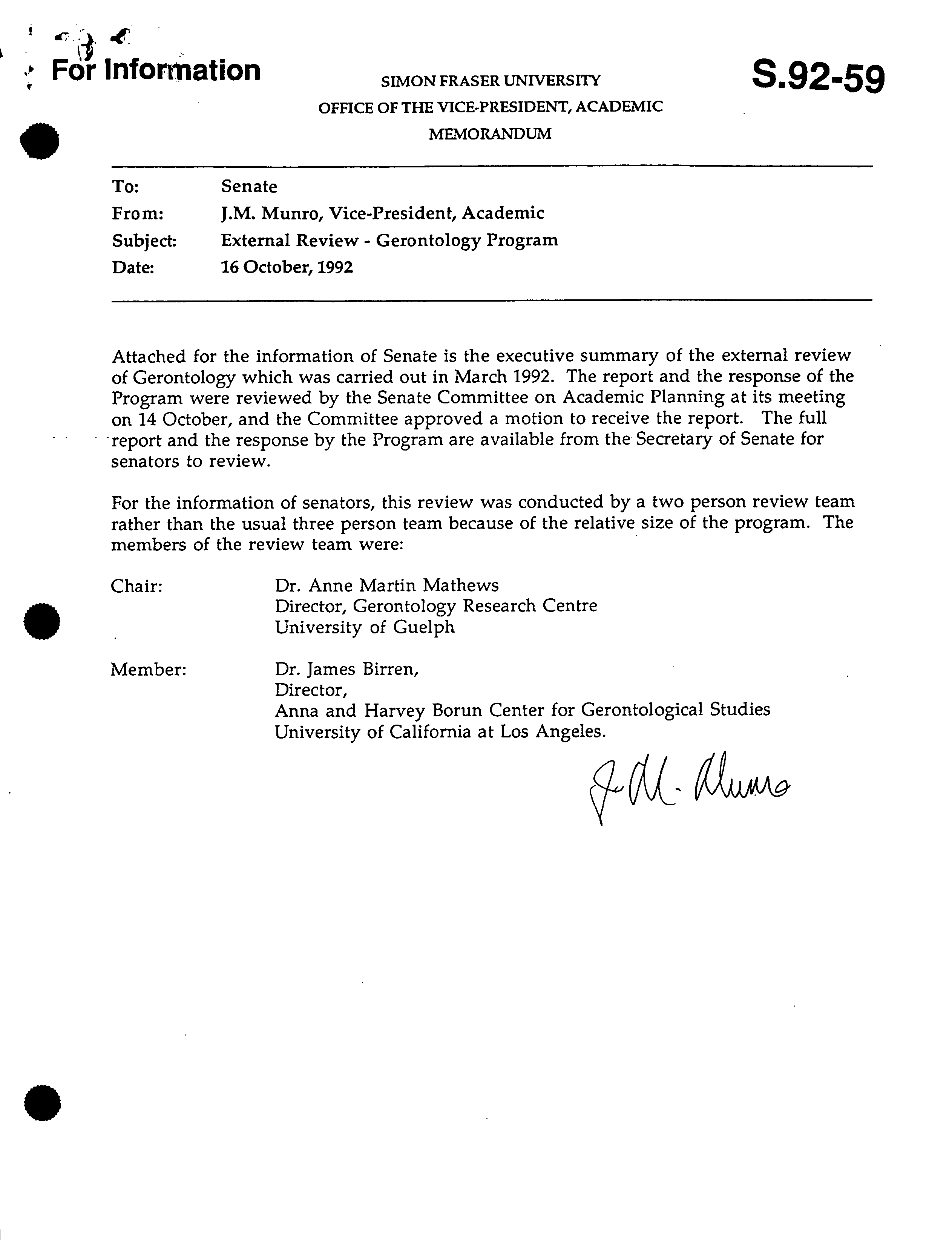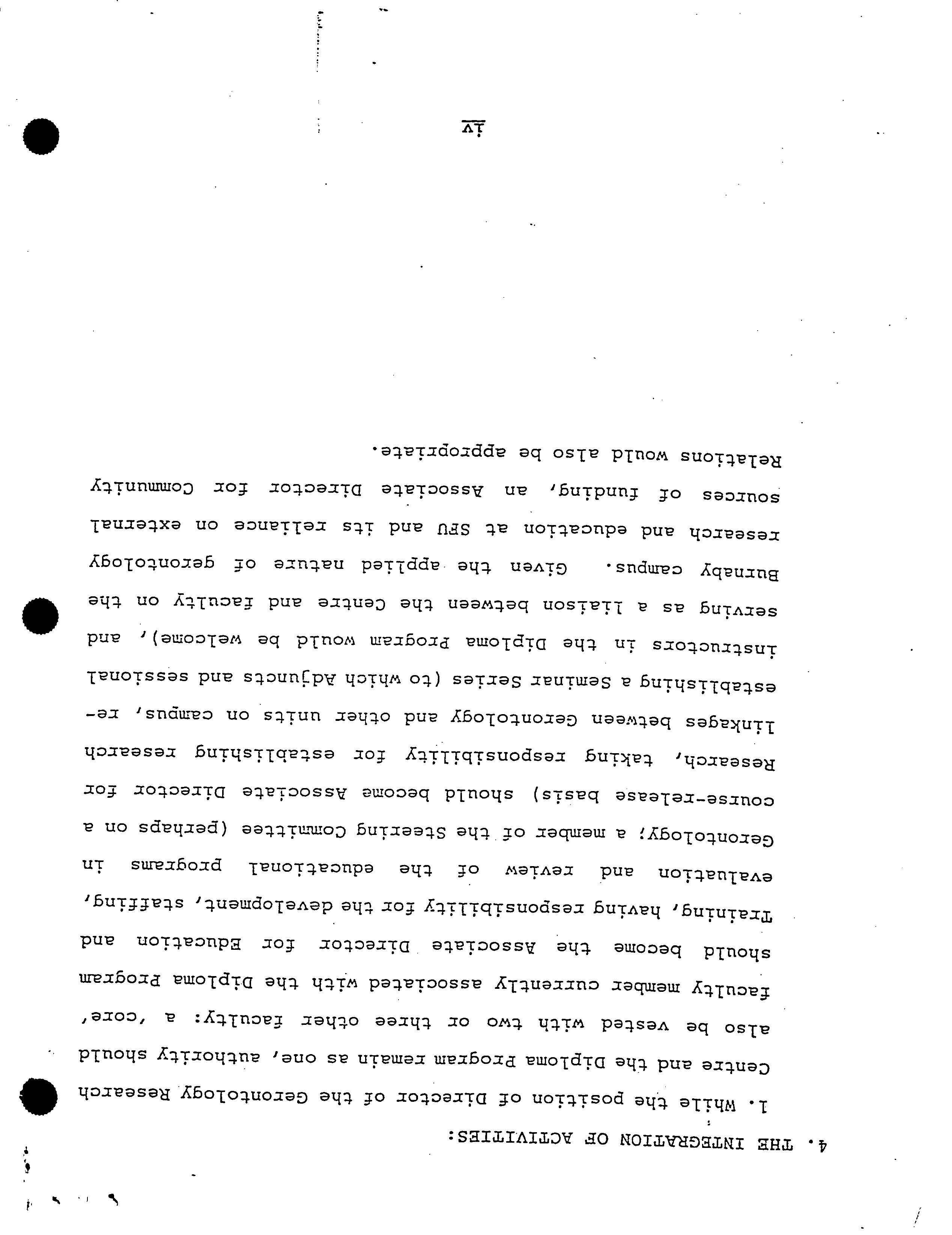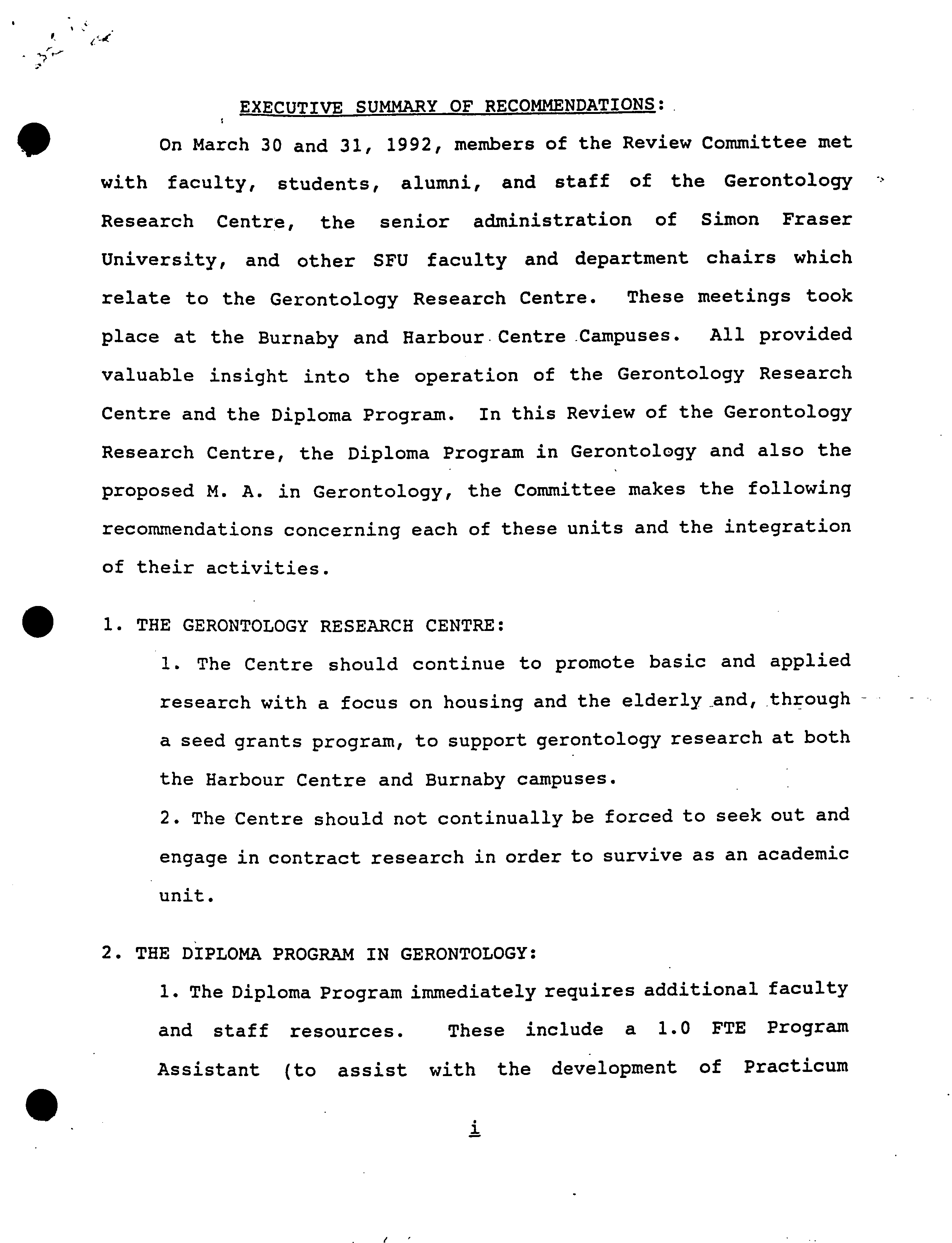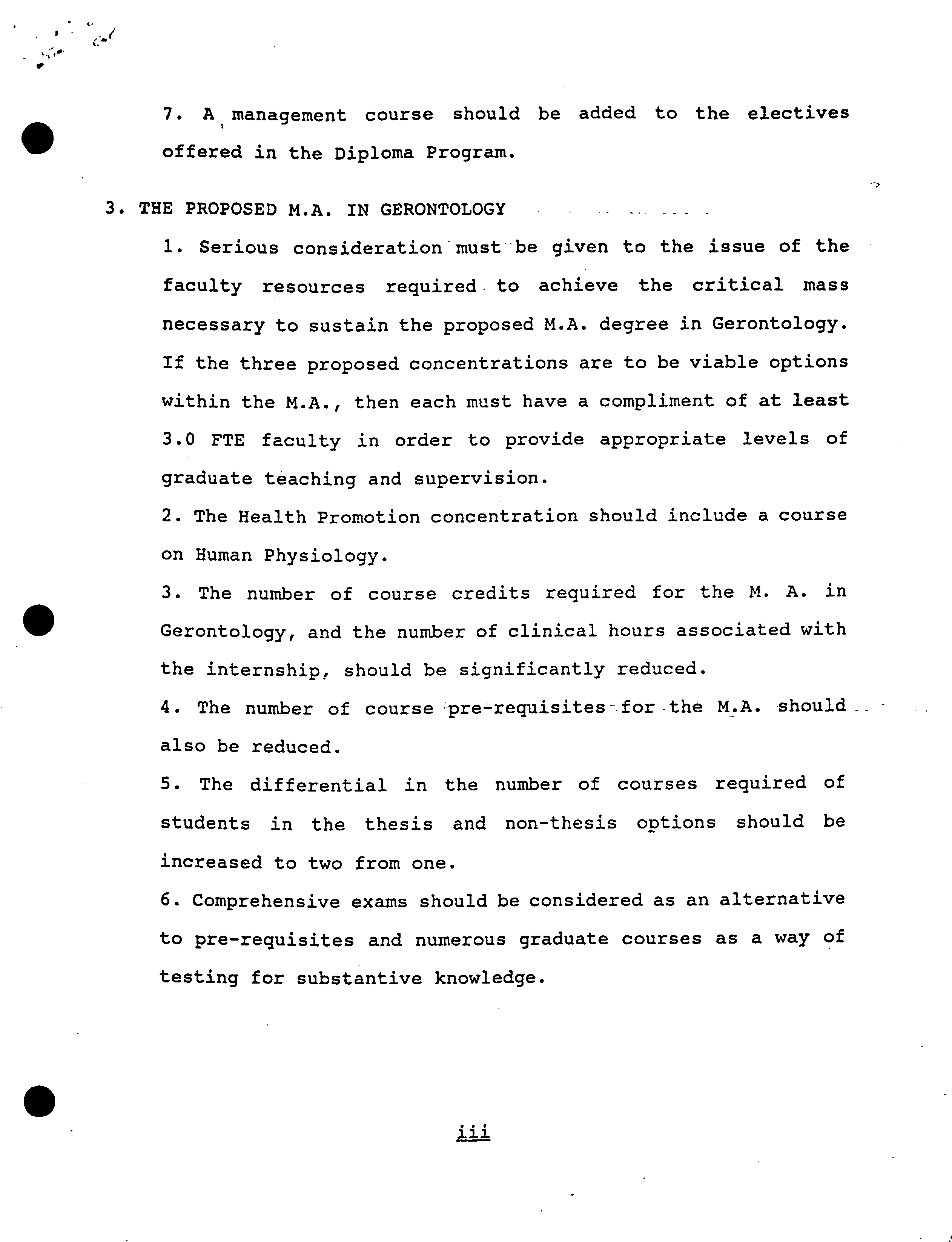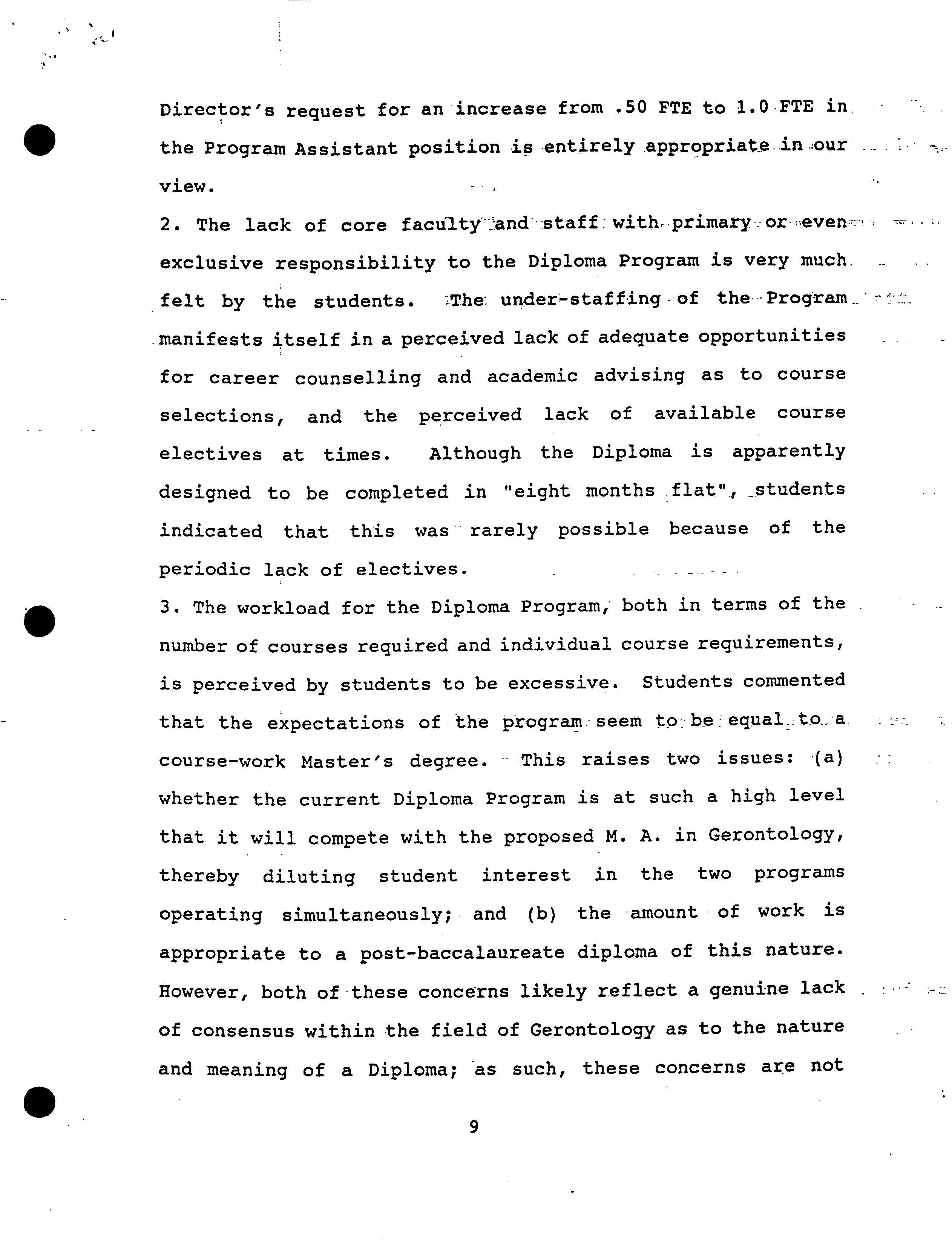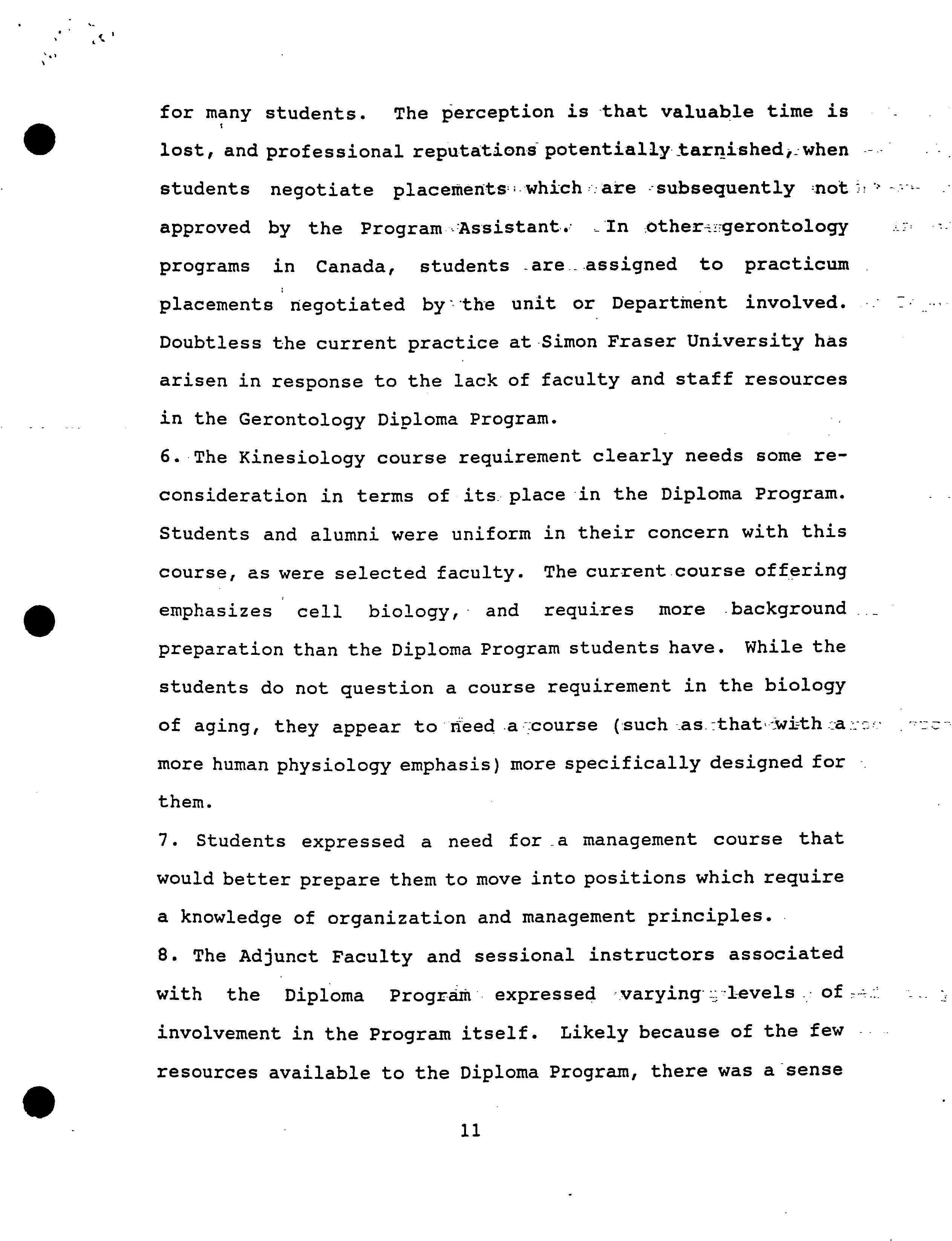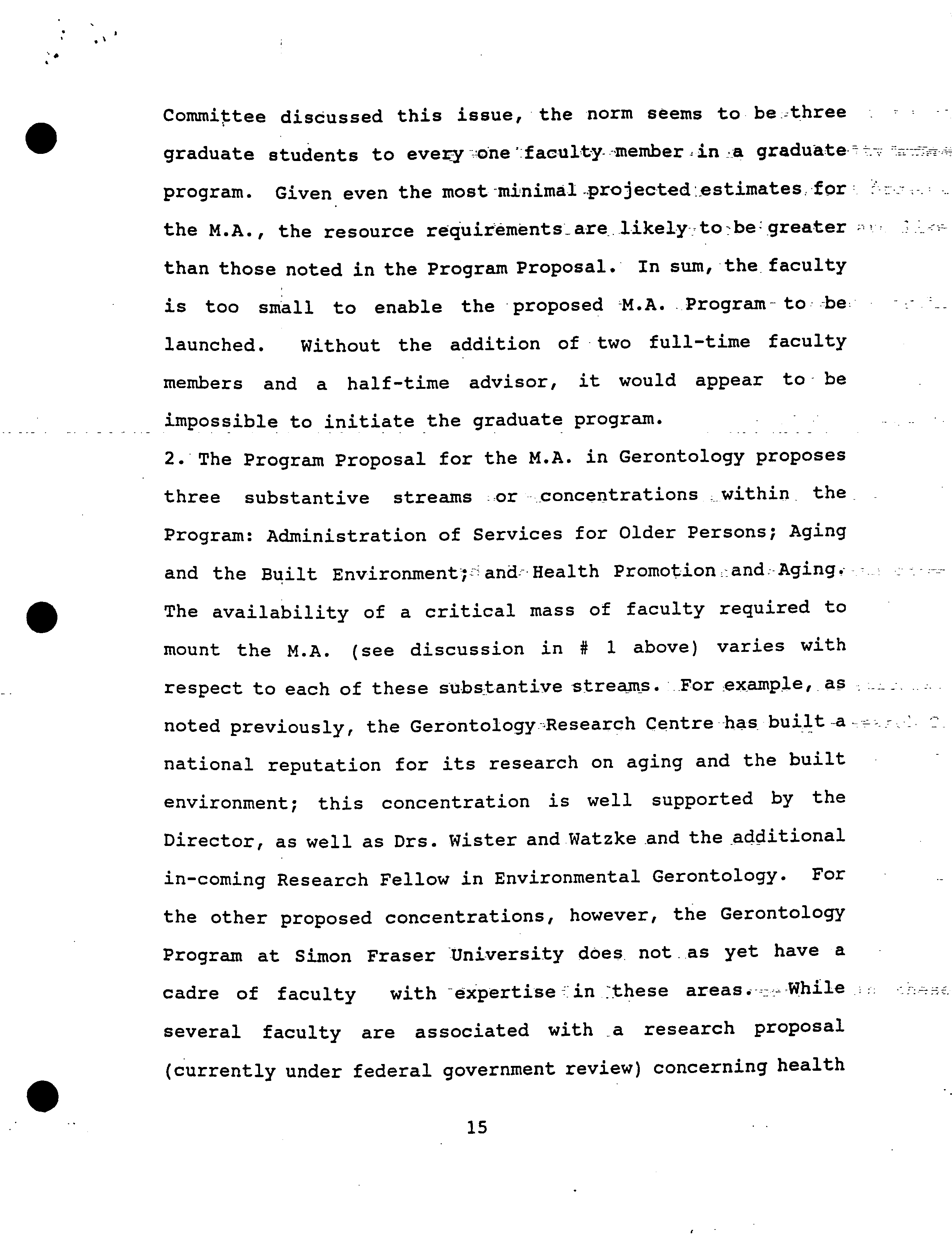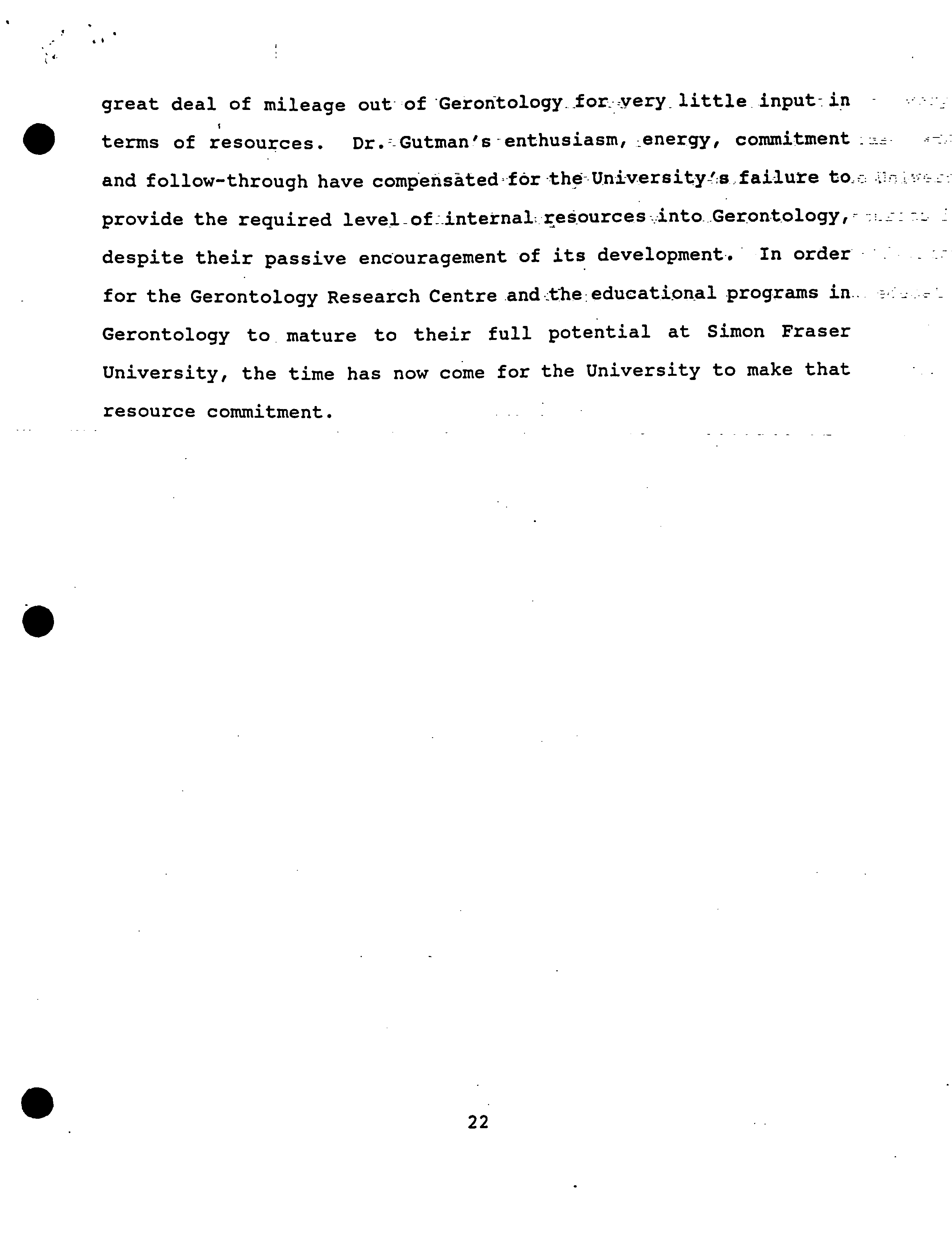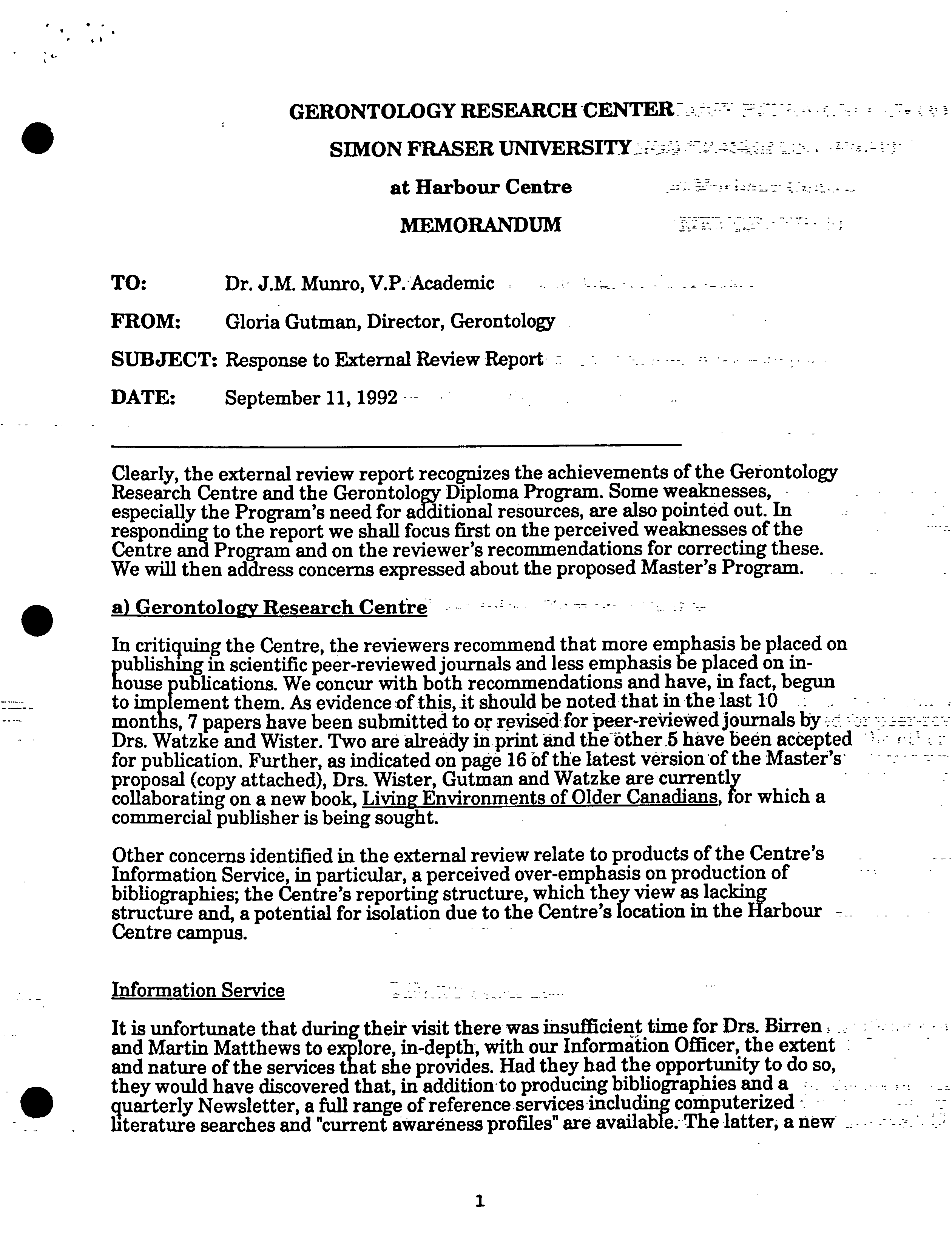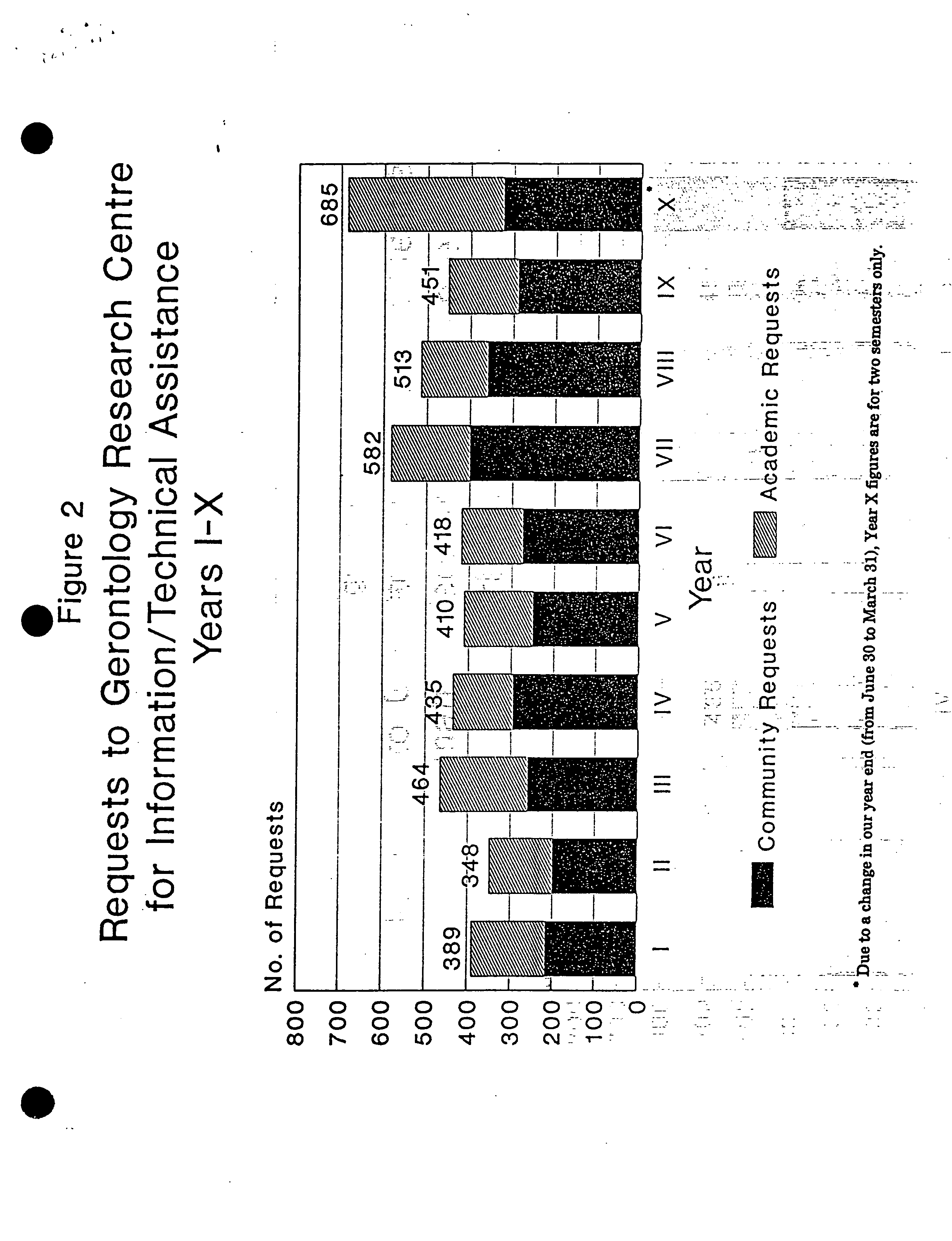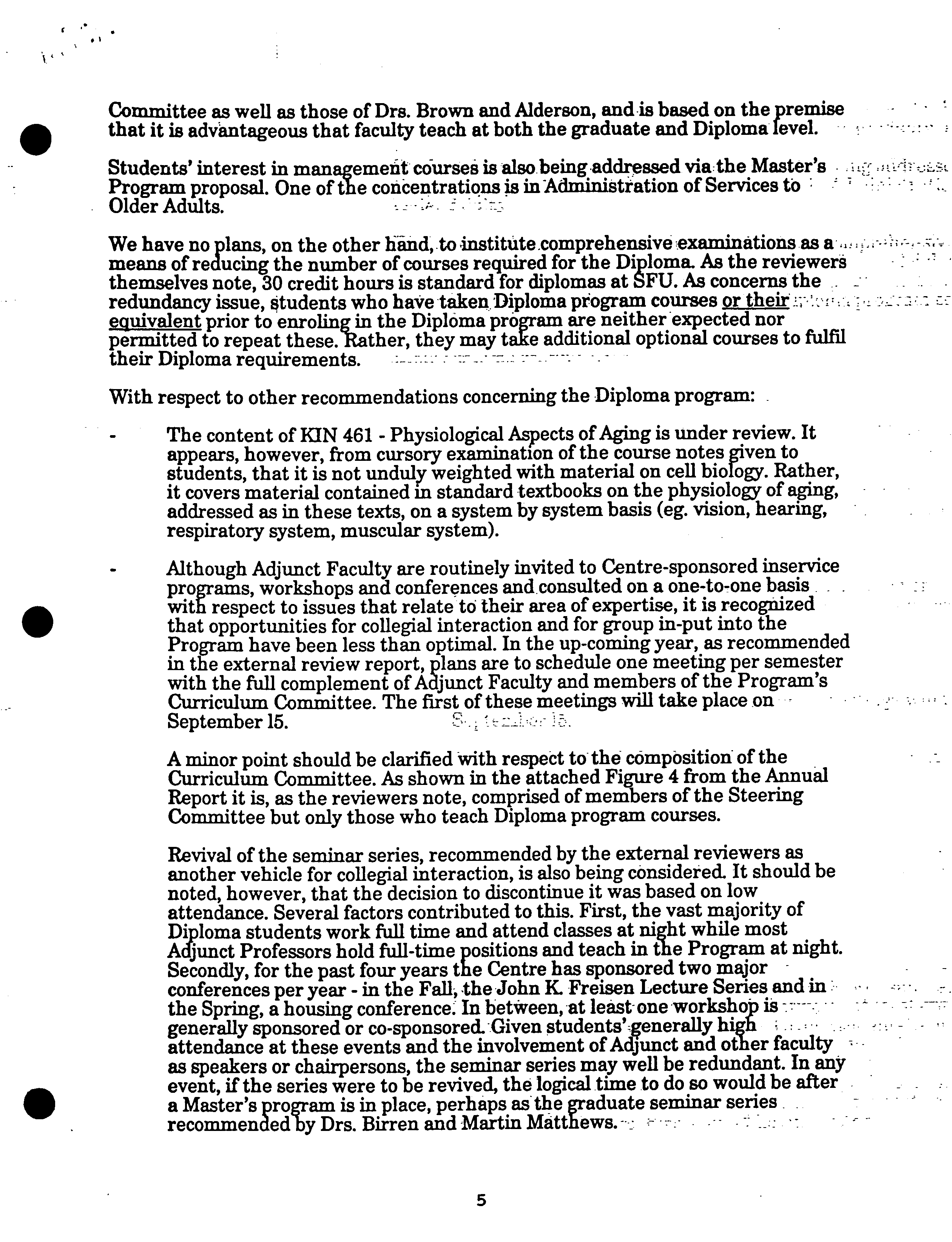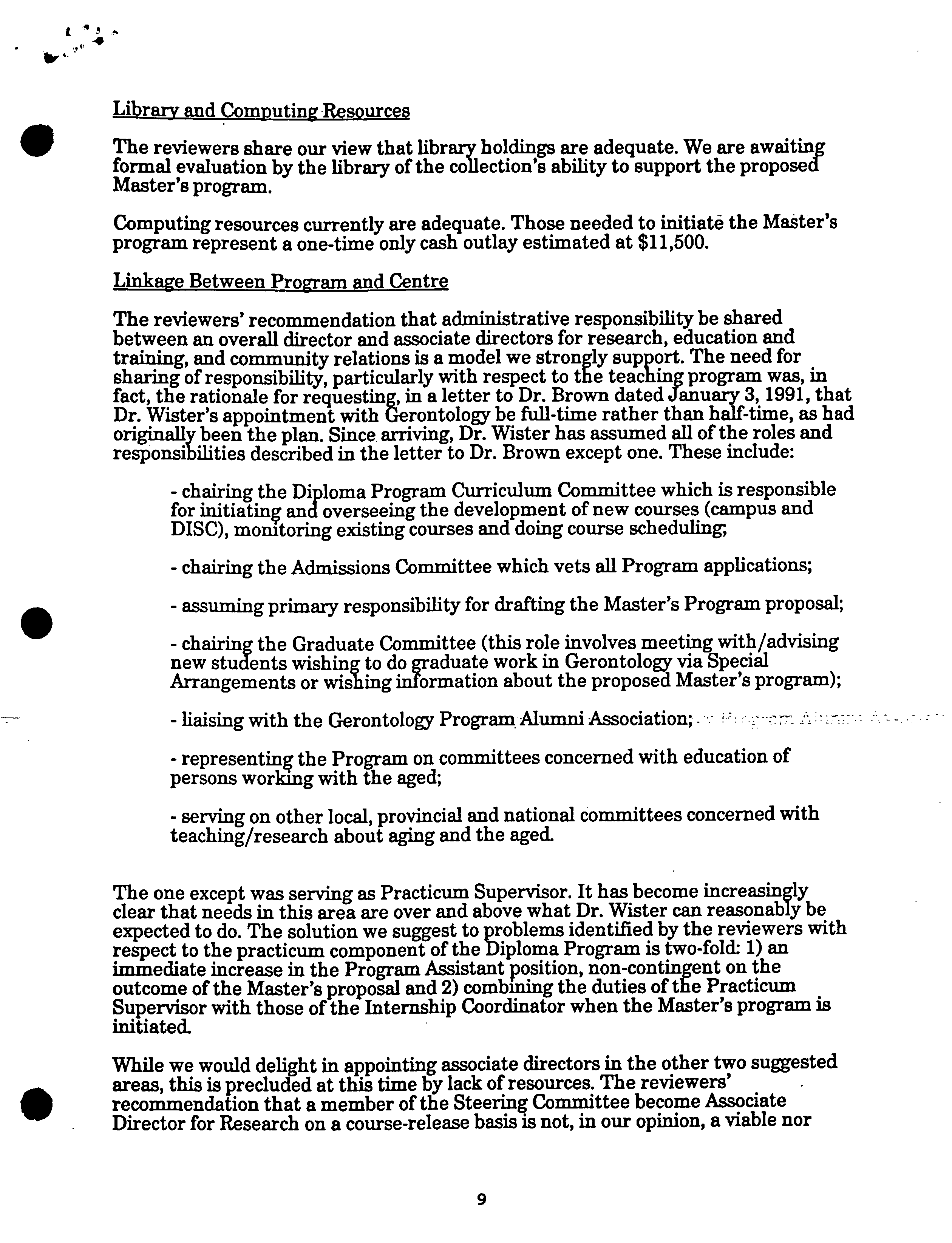For Information
SIMON FRASER UNIVERSITY
S.92-59
OFFICE OF THE VICE-PRESIDENT, ACADEMIC
.
MEMORANDUM
To:
Senate
From:
J.M. Munro, Vice-President, Academic
Subject:
External Review - Gerontology Program
Date:
16 October, 1992
Attached for the information of Senate is the executive summary of the external review
of Gerontology which was carried out in March 1992. The report and the response of the
Program were reviewed by the Senate Committee on Academic Planning at its meeting
on 14 October, and the Committee approved a motion to receive the report. The full
report and the response by the Program are available from the Secretary of Senate for
senators to review.
For the information of senators, this review was conducted by a two person review team
rather than the usual three person team because of the relative size of the program. The
members of the review team were:
Chair:
Dr. Anne Martin Mathews
Director, Gerontology Research Centre
University of Guelph
Member:
Dr. James Birren,
Director,
Anna and Harvey Borun Center for Gerontological Studies
University of California at Los Angeles.
k -
40-0
CPTIVE SUMMARY OF RECOMMENDATIONS:
On March 30 and 31, 1992, members of the Review Committee met
with faculty, students, alumni, and staff of the Gerontology
Research Centre, the senior administration of Simon Fraser
University, and other SFU faculty and department chairs which
relate to the Gerontology Research Centre. These meetings took
place at the Burnaby and Harbour Centre Campuses. All provided
valuable insight into the operation of the Gerontology Research
Centre and the Diploma Program. In this Review of the Gerontology
Research Centre, the Diploma Program in Gerontology and also the
proposed H. A. in Gerontology, the Committee makes the following
recommendations concerning each of these units and the integration
of their activities.
0
1. THE GERONTOLOGY RESEARCH CENTRE:
1.
The Centre should continue to promote basic and applied
• research with a. focus on housing and the elderly and, through
a seed grants program, to support gerontology research at both
the Harbour Centre and Burnaby campuses.
2.
The Centre should not continually be forced to seek out and
engage in contract research in order to survive as an academic
unit.
2. THE DIPLOMA
PROGRAMIN GERONTOLOGY:
1. The Diploma Program immediately requires additional faculty
and staff resources.
These include a 1.0 FTE Program
Assistant (to assist with the development of Practicum
S.
/
-
q
q
p
TadoaddP a.xow eq
PT
nOm
senssr sseut-rt pzre t4T29q
o.uT
uo
T;T
sue
:rog TT;
uod
;a.xTp e:toui
q;p AOToTsAqd
ueulrat
U
T
es.:zflO:D
v 'QToTq
TT90
UO
STsqduia
e;
q
'uri5o.z
wo
T
d
Ta
etiq o; uoq.nqT.;uo3 s;-r
go suq
UT
P9M97A9a eq
PTnOqs
quawaaTnbaa esnoo ASoToTseu-r)I 9T4,
9
,ee.zBep uoTu2duIoo,
P
s (pe;outo.zd pup) prA eq -
seq
PTflOT4S
4T
a9q
4
;97
q
mzo
';ueuxAo1duEe o;uT ez;ue enbep u
s3pTAod euo
uxod
et.q xeqeq.i o s
p
uT;.eun Tee ruulnw
ur2thold UIoTdTG
9L
I4
;° T"T P
up
suepn;s o; PePTAO.Xd
• eq
PT
fl0T
4
9 BuT
TT
9sunOO a9GaPO ac
-
I
SeTTun;1oddo
e.ow
s
ST;recIXe
4UaTOT
3g
nS
2A2r
Aui
sUeptiq.s aaaLlm s
p
aa
p
UT
A
TT'T
e2
load
uxoTdt
UT
squameaTnbai esnoo go aaquinu eqq. BuTonpaa aoT UISTU2439U1
2
S2 peepTsuoD eq prtot.s suoT;u-turxe
eAT
sueedwo3 •
pe-raz eq pnoqs 'sr2eA quaoa,
UT
punqiow aa7qq
p
a euxoeq SP4 qoTtM 'seT.res
UTUIeS et
c
UOTnT21e
P
up
b
l
,
9TAaa IUP250ad OTP0TI9d
o ssaord
.ze
f
z
i
ei.
-
4
ur pe5-5ue eq
04
peeu
;ueuzoieAep
9Sflo3 pu
p
UOT;fl;sut
U
T
P
2A
T
OIU
T
A
i
erp
S
T
2n
P
TAT
P
U
T
etpj
ux
tho.z
2UIO
TdTG
94
TT
pe;TzOsSe S1Ofl14SUT TUOTsses pup
A;ne; ounCpy eq t;rit pe1
.
nba1 axe s5wrqeeuz .
T2
TnBe.r e.xo
•UoTuTp.003
Wn
T
nOTfl
D
.xo;
TTTqsuodse.
eA2q
pftt049
suoT;Tsod
AqTnD'e3
asaqq
10
A
4T
nZ2
;
T
U0
TTPP
sr P
up
os
ueet;eq pup (s;ueueD21d
d
7. A management course should be added to the electives
offered in the Diploma Program.
3. THE PROPOSED M.A. IN GERONTOLOGY
1.
Serious consideration must be given to the issue of the
faculty resources required to achieve the critical mass
necessary to sustain the proposed M.A. degree in Gerontology.
If the three proposed concentrations are to be viable options
within the M.A., then each must have a com
p
liment of at least
3.0 FTE faculty in order to provide appropriate levels of
graduate teaching and supervision.
2.
The Health Promotion concentration should include a course
on Human Physiology.
3.
The number of course credits required for the
M. A. in
G
erontology, and the number of clinical hours associated with
the internshi
p
, should be significantly reduced.
4.
The number of course pre-requisites for the
M.A. should
also be reduced.
S. The differential in the number of courses required of
students in the thesis and non-thesis options should be
increased to two from one.
6. Comprehensive exams should be considered as an alternative
to pre-requisites and numerous graduate courses as a way of
testing for substantive knowledge.
i
S. -
Iii
'94PT-7doadde eq
OS
T
P p
i
no
M
suoTqpTa
d
o; io;ar
-
r ;94-2-roossV UP
UTptIfl; ;o Seznos
UO
aOuVT
T
aa
ST
P
UP
flS
qP UQTDrtpa PUP 4ese
A6oiouo.95 go ezn;Pu
P
9
TT
dd
eq; ue.-
ridux
Aquzn
Gq4 UO
A
;fl; P
UP aa
4
ua
D
eqq Ueat;eq uos-r-rT
P
UP
'(eu.zooTeM eq PT
flOM
ui't5orc
UIOTdT(j eq UT S.XO4On;SUT
TU0TSSeS pue SUflCpj TtU o)
TS .
PU
T
UIa
S
'
-a 'snduiez) uo Sun 1e40 PUPA50-0uoa-j Uee!;eq
s
eeu-
qieese.z 5U4ST[q2;se o; I;TTqsuodse1 hupj; 'zes
io; .xoe.i-ra
;
a-4
-
e
-
,Dossv euzoeq pnoqs (s-rseq eseTees.noo
P uo sdeqied) ee-ruzuio Euzee;s aLiq
go
.equieux
0Touo
UT suratho.id T
eu
oT;e3np eq; ;o MeTAaX P
UP
uOr;2nTAe
'buT;;es '
ueuxd
oieiep aq; .io; A
rqrsuodsa Upeq BUTuTe
pue
UOT
,e3flpa :io
°'TG
e
4eT3ossv e; euzo3eq PTrtots
ur2-
.S0.z
euxo
l
di
a
aq4 tin
-rTm peeToosse
A
Tue..n3
aa
qmaur A;nDe;
:A;inor 1eo ee.zq .xo o;
t
T
E
'
pa;seA
eq os-1e
PT
tlOtjS A
T
.I0
qne 'euo
SP
UTPwaa U11O.Xa -euIOTd-rCl eq; pue e4u33
taxeesej
A5o
i
ouoie
et; go
10.r
ra
;o
uo
T;T
so
d
at['
t eTq
:
sIIAID
y
ao HOl 1Dati aHr
.
•i
-
SCAP 92 - 32
REPORT OF THE EXTERNAL REVIEW COMMITTEE
FOR THE GERONTOLOGY RESEARCH CENTRE
AND DIPLOMA PROGRAM IN GERONTOLOGY
AT SIMON FRASER UNIVERSITY
S
Submitted By:
James E. Birren, University of California at Los Angeles
Anne Martin Matthews, University of Guelph (Chair)
JUNE 1992
/
EXECUTIVE SUMMARY OF RECOMMENDATIONS:
On March 30 and 31, 1992, members of the Review Committee met
with faculty, students, alumni, and staff of the Gerontology
Research Centre, the senior administration of Simon Fraser
University, and other SFU faculty and department chairs which
relate to the Gerontology Research Centre. These meetings took
place at the Burnaby and Harbour. Centre Campuses. All provided
valuable insight into the operation of the Gerontology Research
Centre and the Diploma Program. In this Review of the Gerontology
Research Centre, the Diploma Program in Gerontology and also the
proposed M. A. in Gerontology, the Committee makes the following
recommendations concerning each of these units and the integration
of their activities.
1. THE GERONTOLOGY RESEARCH CENTRE
1.
The Centre should continue to promote basic and applied
research with a focus on housing and the elderly..and, through -
a seed grants program, to support gerontology research at both
the Harbour Centre and Burnaby campuses.
2.
The Centre should not continually be forced to seek out and
engage in contract research in order to survive as an academic
unit.
2. THE DIPLOMA PROGRAM IN GERONTOLOGY:
1. The Diploma Program immediately requires additional faculty
and staff resources. These include a 1.0 FTE Program
Assistant (to assist with the development of Practicum
1.
C.
placements) and between .50 FTE and 1.5 FTE additional faculty
resources.
One
of
these
faculty
positions
should
have
responsibility for Curriculum Coordination.
2. More regular meetings are required with the Adjunct faculty
and sessional instructors associated with the Diploma Program.
The individuals directly involved in instruction and course
development
need to be
engaged
in the
larger process of
periodic Program review and evaluation.
3. The Seminar Series, which has become rather moribund in
recent years, should be revived.
4.
Comprehensive
examinations
should
be
considered
as
a
mechanism for reducing the number of course requirements in
the Diploma program, especially in areas where students may
S
have
sufficient expertise.
5.
More
opportunities
for
career
counselling
should
be
provided
to
students
and
alumni
of
the
Diploma
Program.
Alumni feel uncertain as to whether the Diploma alone provides
an adequate entre into employment, or whether it should best
be viewed (and promoted) as a 'companion degree'.
6. The Kinesiology course requirement should be reviewed in
terms of its contribution to the Diploma Program.
Rather than
the current
emphasis
on
cell
biology,
a course
in
human
physiology with more direct potential for translation into
practical health and illness issues would be more appropriate.
'-1-
-
...
•
7. A management course should be added to the electives
offered in the Diploma Program.
3. THE PROPOSED M.A. IN GERONTOLOGY
1.
Serious consideration must'be given to the issue of the
faculty resources required. to achieve the critical mass
necessary to sustain the proposed M.A. degree in Gerontology.
If the three proposed
concentrations
are to be viable options
within the M.A., then each must have a compliment of
at least
3.0 FTE faculty in order to provide appropriate levels of
graduate teaching and supervision.
2.
The Health Promotion concentration should include a course
on Human Physiology.
3.
The number of course credits required for the M. A. in
40
Gerontology, and the number of clinical hours associated with
the internship, should be significantly reduced.
4.
The number of course --pre-requisites - for.the M.A. should
also be reduced.
5.
The differential in the number of courses required of
students in the thesis and non-thesis options should be
increased to two from one.
6.
Comprehensive exams should be considered as an alternative
to pre-requisites and numerous graduate courses as a way of
testing for substantive knowledge.
S
11]
4. THE INTEGRATION OF ACTIVITIES:
1. While the position of Director of the Gerontology Research
Centre and the Diploma Program remain as one, authority should
also be vested with two or three other faculty: a- -'core'
-. -
faculty member currently associated with the Diploma Program
should become the Associate Director - for Education and.
Training,
having responsibility for the development, staffing,
evaluation and review of the educational programs in
Gerontology; a member of the Steering Committee (perhaps on a
course-release basis) should become Associate Director for
Research, taking responsibility for establishing research
linkages between Gerontology and other units on campus, re-
establishing a Seminar Series (to which Adjuncts and sessional
instructors in the Diploma Program would be welcome), and
serving as a liaison between the Centre and faculty on the
Burnaby campus. Given the applied nature of gerontology
research and education at SFU and its reliance on external
sources of funding, an Associate Director for Community
Relations would also be appropriate.
co
iv
-'
REVIEW OF GERONTOLOGY RESEARCH AND PROGRAMS:
INTRODUCTORY REMARKS:
-•
Prior to our visit, members of the Review Committee received
and read a variety ofReports and documents relating to the
Gerontology Research Centre and the Diploma in Gerontology. These
included: the 1990-91 Anhuai:
.
Report-ofth
e
Geronto1ogy-Research- -
Centre; information on the Post Baccalaureate Diploma in
Gerontology; the Program Proposal for the Master of Arts in
Gerontology (dated 92.02.26); the University Calendar; Challenge
2001: The President's Strategic Plan; and the curriculum vitae of
Centre core faculty.
On March 30 and 31, 1992, we met with
faculty, students, alumni, staff and senior administration at the
Burnaby and Harbour Centre Campuses. All provided valuable insight
•
into the operation of the Gerontology Research Centre and the
Diploma Program
and
the proposal for a M.A. degree in Gerontology.
Among gerontology centres
and
programs in Canada, the SF13
facilities are well known and have- awide -measure of respect. The
productivity of the Centre in terms of research reports and funding
secured is widely acknowledged. During our visit it became
apparent that the Centre and the Diploma Program enjoy the broad
support of their constituent faculty, students and alumni, as well
as the senior administration of the University.
In order to adequately address the many and various issues
involved in the evaluation--of the Gerontology Research Centre, the
Diploma Program and the proposed M.A. in Gerontology, each of these
three components will be addressed separately. Interrelationships
1
between the three will be considered in the last section of this
Review.
-
THE GERONTOLOGY RESEARCH :CENTRE::
Strengths:
1. The Centre is a model of whatcanbeachievedgiVen'modest --
funding
over a decade. The SFU Gerontology Research Centre
has a solid
national
reputation and enjoys some international
recognition
as well.
• 2. A major achievement has been the
contribution
of the Centre
to our understanding of the relationship between the aging
individual and the built
environment.
• 3.
The endowment from the Real Estate Foundation of B.C.,
which funds two Research Fellowships
:
in Environmental
Gerontology in the Centre, is a particularly notable
accomplishment. These positions provide a unique opportunity
for the Centre to further nhanceT:its. expertise in the areas
of aging and the built environment.
4. The Centre has a particularly strong leader in the person
of Dr. Gutman. She has been especially successful in securing
on-going funding
for the Centre and in establishing the
Centre's national reputation. Colleagues, staff and students
applaud the drive and energy she has brought to the task of
building the Centre and the Diploma Program. As one faculty -
- - -
member noted, "The Centre seems to have grown with its Own
force and that force-is Gloria". Another observed that few
other programs at Simon Fraser are so identified with the
initiative
of one
person
as
is
the Gerontology
Research
Centre.
5.
Through
the
production
of
bibliographies
and - the
accumulation of resource materIal,
the
:
Cent-r.e--had-.:becôme a
visible
and
viable
resource
for
faculty,
students
and
community
t
groups
who
seek- bibliographic
information
for
gerontological research.
6. The Centre had demonstrated an ability to attract grants
and contracts from a variety of
funding
sources. This has
been accomplished despite
national
concerns about continuous
funding for research in the social sciences and humanities.
7. The growth in funding and published work, much of it in in-
house publications, has been very impressive.
The prospects
•
for further growth appear to be quite encouraging.
Several of
the core faculty associated with the Centre
(notably Drs.
Wister and Watzke) are in the early stages of their careers
and are
still building their researc•h prograrns.:
::AS
these:..-
research programs develop,
they should further enhance the
Centre's
scholarly output,
especially
in
scientific
peer-
reviewed publications.
8. Although the Centre's primary research focus to date has
been on the topic of aging and the built environment, other
researchers associated with the Centre have developed solid
reputations for research: in ,other areas..
For example, :the
work of Dr.
Gee on issues of family structure and issues
related to women and aging is also widely recognized and well
S.
-
3
,.. I.
I
respected within the broader field of Canadian social
gerontology. Other faculty associates
-
-working in. .areas .of..--
Women's Studies and the applied social sciences similarly
enjoy national reputations.
9. Previously shuttled around from one location to another,
The Gerontology Research Centre .:now -.en-joys -'a.: permanent-- and:, -:
spacious home in Harbour Centre.
This location greatly
facilitates the Centre's access to constituent groups such as
- -
students and the community.
-
Weaknesses to be Addressed:
1.
The number of papers publishedinscientific peer-review.
journals needs to be increased, in order to realize the full
maturity of the research programs of Centre faculty and
Sassociates.
2.
Faculty need to publish more of their gerontology research
in sources other than in-house publications which, may
--
xiot_ have-
as wide a distribution and the visibility - of commercial ..
academic presses.
3.
Although the role of the Information Officer is a valuable
one, the time has now come to focus attention away from the
production of in-house Bibliographies. To date the Centre has
produced some 192 Specialized Bibliographies. As the Centre
moves into its second decade, _this kind, ofass
.
istaflCe to .
faculty and students amy-2become. less-.. important- both as ..--
computer technology facilitates this process and as the
academic programs mature.
-
V
4.
The, reporting structure of the -Centre needs to be
5
clarified.
It appears- that some : measure --of budget
accountability is to the donors-of the endowment-fund. While
the Centre also reports tothê:Dean of -Arts frequency and
timing of such reporting- is not clear, nor is the nature of
the action called for in -response -to -such reports.--- The -lack
of University financial support to the Centre likely
contributes to its somewhat autonomous character; in such a
climate, success must therefore be judged in terms of its
service to the community and its applied orientation, more
SO
than its relationship to scholarship and faculty research. If
there are to be increased faculty efforts to further the
research goals of the Centre and to involve it in more
S
research grants than contracts, then the relationship between
the Centre and the University, both financially and
organizationally, requires clarification.
5.
Concerted effort will be requiredovertimeto ensure that -
the Harbour Centre location does not isolate Burnaby Campus
faculty from the Gerontology Research Centre and from library
holdings in Gerontology.
Recommendations for the Future:
1. The Centre should continue to promote basic and applied
research with a focus on housing and the elderly. Through .a
seed grants program, the Centre should-- continue to support
gerontology research at both the Harbour Centre and Burnaby
0
-
campuses.
5
2. The Centre should not continually be forced
- to seek out and
engage in contract research-in order -toSUrViVe..asan academic
-
unit. The SF13 Gerontology..ResearChCe
flt
r
e
is unique among --
Centres in Canada in the
to
attract endowment support and thus, sustain itself almost
exclusively on
a resource base frOm outside the University.
-
This is an extraordinary achievement. However, across ensuing
years, and particularly in light of the anticipated re-
capitalization of some of the endowment funds, the Centre must
not continually be required to sustain all of its operations
through external funding, especially contract funding.
THE DIPLOMA
PROGRAM IN GERONTOLOGY:
The Post-Baccalaureate Diploma Program in Gerontology has 87
graduates and 95 registered students (as of the 1990-91 Annual
Report). As part of the Review of the Diploma Program, the
Committee met with faculty -and i also :two groups
-
-of students:,- -twelve
who are currently registered in a 400 level Diploma course, and six
graduates of the Diploma program. The consensus among the student
groups was that a great deal has been accomplished by the Diploma
Program with very limited resources. They agreed with the
observation that "there should be more bouquets for what has been
accomplished".
Strengths:
1. The number of graduates of the Diploma Program and the
levels of enrolment (both in terms of the number of students
-7
L!J
'I
registered
in
the
Program
as
well as
the
.
994 course
enrolments)
together indicate that the Diploma Program is
meeting a need in the community.
2.
The
Committee
was
;the
•
students and the alumni, based on our brief meeting with them.
They came
from a wide
variety '-of 'background's, had- strong
commitment to gerontology and had a great deal of respect for
the what they had learned and how it had contributed to their
careers
in
gerontology. They
were
very articulate
in
expressing their views as to the strengths and weaknesses of
their courses and the Program overall.
They are indeed a
credit to the quality and strength of the Program.
3. The Alumni in particular are .ahighly motivated group, and
•
with their
'
in-put and continuing interest can continue to be
a
true
asset
to
the Program
as
it
shapes and
evolves
(especially with the introduction of the proposed M.A.
in
Gerontology) in the years' ahead.
4. The Program is unique in the province of British Columbia
and one of only several in the country.
5.
The
Program is
designed to be
flexible
enough
that
a
variety of course electives are available to students to meet
their particular interests and needs.
6.
The relevance, of
the Program for the
field of
social
gerontology is apparent.
The 'core' required -courses cover
the primary issues of relevance to the field, and the range of
electives is reasonably broad but also intensive and focused.
7
1
7. The Program is still at a point -where class size is
small enough to facilitate stimulating
classroom..inter-action:
between students and faculty.- Many:students -descri-bed this
a strength of the Program.
Weaknesses to be Addressed:-_-: -
1. The Diploma Program has, until quite recently, operated
with an appalling lack of committed faculty resources,. in
terms of Full-Time Equivalents (FTEs). Up until September
1991, the Diploma Program was allocated only .50 FTE (Dr.
Gutman) and .50 FTE staff. Even with the welcome addition of
Dr. Wister (1.0 FTE) to the core teaching staff -of the
Program, the allocation of faculty and staff to the Program is
woefully inadequate. The.Diplóma±Program-:faculty resources
are also supplemented by six sessional stipends funded through
the University, and through endowment funds provided by the
Silberfield Lectureship fl-i-n-Gerontology and--Squibb Canada.
While obviously a Program such as this will- always -rely -
to some extent on sessional instructors and faculty in other
Departments to mount the broad range of electives required as
part of the curriculum, the Diploma Program currently relies
far too extensively on sessional instructors to mount its
curriculum. During our visit, we learned, for example, that
programs such as Women's Studies have 3.0 FTEs based.-On 17
students.
At that rate, - the 95 students enroledin the- - -
Diploma Program in Gerontology would appear to warrant more
•
than the current 1.5 FTE faculty allocation. The Program
8
Director's request for an increase from .50 FTE to 1.0-FTE in.
the Program Assistant position is entirely apprqpriate..ifl-our
view.
2. The lack of core facu1tyandstaff with primary-: or-even-
exclusive responsibility to the Diploma Program is very much
felt by the students.
The: under-staffing
.
of the•--Program;
manifests itself in a perceived lack of adequate opportunities
- -
for career counselling and academic advising as to course
- -
-
selections, and the perceived lack of available course
electives at times. Although the Diploma is apparently
designed to be completed in "eight months flat"., .students
indicated that this was rarely possible because of the
periodic lack of electives.
- - - - - -
• 3. The workload for the Diploma Program, both in terms of the
number of courses required and individual course requirements,
is perceived by students to be excessive. Students commented
that the expectations of the program: seem tp
: beequal;to. -a
course-work Master's degree. ---This raises two issues: -(a)
whether the current Diploma Program is at such a high level
that it will compete with the proposed M. A. in Gerontology,
thereby diluting student interest in the two programs
operating simultaneously;
• and (b) the -amount of work is
appropriate to a post-baccalaureate diploma of this nature.
However, both of these concerns likely reflect a genuine lack ,:---
of consensus within the field of Gerontology as to the nature
- -
and meaning of a Diploma; as such, these concerns are not
9
unique to Simon Fraser University.. The number of credit hours
required for the Diploma-is in-fact.-coflsistentT-with similar :--: - -
Programs
at Simon Frase
University;
.
-f acuity perceive the"'
workload as appropriate to the course..level-s..---Neverthelessr-
given the concern
expressed
by students, some consideration
could be given to whethera5OO1eVel. course designation may
be more appropriate for some of the.-.Gerontology courses.
4.
One
suggested
alternative
is
that
comprehensive
examinations
be
organized
as
another
way of
determining
student's level of knowledge.
In addition, they could be used
as a means of determining whether students -should be waived of
core course requirements in areas where they have sufficient
background.
Students did note,-however, that if they 'skip'
courses they have already taken elsewhere, then there may not
be enough electives available to complete the Diploma Program
within a given time period.
In. such cases., the waiving of
certain course requirements for the.Diploma --may be required.
. ..
5. The practicum requirement, although viewed by the Committee
as an overall strength of the Program,
is problematic for
students in terms of the amount of support they receive in
identifying practicum opportunities.
Presently, students are
required to find a setting for their Practicum, discuss it
with the appropriate administrator, then bring the plan to the
Program Assistant
in
the --.-
Diploma- Program
for: approval
or--
rejection.
The requirement that the students themselves make
arrangements for the practicum is clearly a source of stress
.
-
10
for many students.
The perception
is
-that valuable time
is
lost, and professional reputations
-
potentially
-
tarnished ,:when
students
negotiate
placements- whichare -subsequently not--
approved
by
the Program
ssistant-.'
In .other-gerontology
programs
in Canada,
students
are
assigned to
practicum
placements negotiated by the unit or Department
involved.
-:
Doubtless the current practice at-Simon Fraser University has
arisen in response to the lack of faculty and staff resources
in the Gerontology Diploma Program.
6. The Kinesiology course requirement clearly needs some re-
consideration in terms of its; place in the Diploma Program.
- -
Students and alumni were uniform in their concern with this
course, as were selected faculty.
The cur-rent course offering
emphasizes - cell
biology,
and
requires
more
background - - -
preparation than the Diploma Program students have.
While the
students do not question a course requirement in the biology
of aging, they appear to - need a--:course
(such -as.:thatdth -a:.-:
-
more human physiology emphasis) more specifically designed for --
them.
7.
Students expressed a need for a management course that
would better prepare them to move into positions which require
a knowledge of organization and management principles.
8. The Adjunct Faculty and sessional instructors associated
with
the
Diploma Program
expressed
.
-varying-:-ievels -: of
- --
involvement in the Program itself.
Likely because of the few -- -
resources available to the Diploma Program, there was asense
11
of a lack of 'connectedness' among the faculty group. Faculty
would welcome more opportunity for collegial -interaction and
- -
more on-going involvement in Program curriculum decisions.-
Recommendations for the Fit-ure: --.::-
1.
The Diploma Program should immediately be provided with
additional faculty and staff resources.. A 1.0 FTEPrograxn
Assistant is immediately.- required, to assist with the
development of Practicum placements. In addition, if the
Diploma Program is to have the same faculty-student ratio as
other programs on campus, then it will require between .50 FTE
and 1.5 FTE additional faculty resources. One of these
faculty positions should have responsibility for Curriculum
Coordination.
-
-. -
2. There should be at least one faculty meeting per term for
planning and evaluation purposes. These should include the
Adjunct faculty and session4linstructorsassociatedwith the .
Diploma Program.
The Review Committee understands-- that,- -- -
currently, the Centre's Steering Committee plays a role in
curriculum development; however, not all Steering Committee
members actually teach courses as part of the Diploma Program.
The individuals directly involved in instruction and course
development need to be engaged in the larger process of
periodic Program review and evaluation.
3. Another vehicle for càllegial -interaction is -the Seminar
Series, which has become rather moribund in recent years.
12
Centre staff discussed a plan to revive the Series; the Review
Committee supports this proposal.
4. Comprehensive examinations should be considered as -
mechanism for reducing the number of courserequirjentsin.,.
the Diploma program, especially in areas where students may
have sufficient expertise.
5.
More opportunities for career counselling should be
provided to students and alumni of the Diploma Program.
Alumni feel uncertain as to whether the Diploma alone provides
an adequate entre into employment, or whether it should best
be viewed (and promoted) as a. 'companion degree'.
6.
The Kinesiology course requirement should be reviewed in
terms of its contribution to the Diploma Program. Rather than
the current emphasis on cell biology, a course in human
physiology with more direct potential for translation into
practical health
and
illness issues would be more appropriate.
7.
A management course should be added to the..eleqtives
offered in the Diploma Program.
THE PROPOSED
M.A. IN GERONTOLOGY:
The proposed M. A. in Gerontology represents a logical step in
the structuring of education in Gerontology at Simon Fraser. With
a decade of experience in the operation of a Gerontology Research
Centre and in post-baccalaureate teaching in Gerontology, the
faculty at Simon Fraser are well poised"
-
to -undertake this
initiative in response to societal need.
13
.
Strengths:
1.
Although several Canadian universities. offer graduate
degrees in selected disciplines with a- -specjalization or
emphasis in Gerontology, only two or three -Master-
I
s deqrepp ,in,_._._
Gerontology are offered in English-speaking Canada.
2.
The proposed M.A. will provide an opportunity.
-.-formore
advanced professional training than is currently possible with
the Post-Baccalaureate Program in Gerontology.
3.
Overall, the Gerontology Research Centre at Simon Fraser
University has a knowledgeable and scholarly group of faculty
to support the proposed substantive foci of the Master's
Program.
-
Weaknesses to be Addressed:
1. The Program Proposal for the M. A. in Gerontology
indicates that, in addition to the part-time involvement of
Dr. Gutman, Dr. Wister and the two Research _,Fellows in -
Environmental Gerontology (of whom only -:Dr.WatZke has yet.
-
.
been appointed), the M.A. will require 2.0 FTE faculty
appointments, a .50 FTE Internship Coordinator, and three
additional sessional appointments.
The Review Committee
considers these the absolute minimal requirements to mount the
proposed Program. Although the optimal size of the faculty
and staff compliment will largely depend on the size of ±he
graduate program (for further discussion. of
-
this point, see
item # 3 below), the issue is a critical one
Among the
faculty from various departments with whom the Review -
Committee discussed this issue, the norm seems to bethree
graduate students to every ;one facnit-y---meinber in :a graduate.---
program.
Given even the most ininimaIprojected:estimates for
the M.A., the resource requireIflefltsarelikely7toTbe.greater
than those noted in the Program Proposal.
In sum, the faculty
is
too
small to
enable
the
proposed -M.A.
Program- to: --be
launched.
Without the
addition of two
full-time
faculty
members
and
a
half-time
advisor,
it
would
appear
to be
- -
- impossible to initiate the graduate program.
- --
2. The Program Proposal for the M.A. in Gerontology proposes
three
substantive
streams :or -concentrations
wjthin
the
Program: Administration of Services for Older Persons; Aging
and the Built Environment; and: Health Promotion and;- Aging,
The availability of a critical mass of faculty required to
mount the M.A.
(see discussion in #
1
above)
varies with
respect to each of these substantive streams.
For examp1e,a
noted previously, the Gerontology --Research Centre-has built -a
national reputation for its research on aging and the built
environment;
this
concentration
is well
supported by
the
Director, as well as Drs. Wister and Watzke and the additional
in-coming Research Fellow in Environmental Gerontology.
For
the other proposed concentrations, however, the Gerontology
Program at Simon Fraser uni-versity does. not. as yet have a
cadre
of
faculty
with -expertise "in :these
areas,___ -While
several
faculty are
associated with
a
research
proposal
(currently under federal government review) concerning health
15
-
promotion and aging, core faculty
appointments
have yet to be -
made.
Within the "Administration-of-Services" concentration
the proposed graduate coursesrequiré -faculty with -expertise-
in both Management and inIñfd±mation
.
Systems..
-Although the:
proposal suggests that these could be covered by having two
- -
individuals
each
with
.50 ...:FTE:: appointments,
such -an
arrangement may contribute little to the
•
critical mass of
full-time core faculty required to successfully mount a viable
graduate program within each of the three substantive streams.
3.- The
enrolment
predictions
for
the
proposed
M.A.
in
Gerontology
suggest
that
there
will
be
a maximum
of
15
students for each of the three substantive streams per year.
This extremely ambitious projection is much too high.
At this
•
rate, a two-year M.A. program would be admitting 45 students
- -
per year, and would easily have upwards of 90 students in the
Program.
This would place it on a par with the very large and
established
graduate
programs -in- Psychology
(-10.0: graduate
students)
and Kinesiology (60 students)
and far larger than
the
15
graduate. students
in Sociology.
Given that these
established programs have between 15. and 33 faculty to support
that number of graduate students, the projected target for
Gerontology seems particularly -high.
If indeed the program
retains
the three
substantive
streams,
then a maximum of
between three and five admissions per year in each - strealn.-
would appear more appropriate relative to other units on
campus.
.
16
4. The number of credit hours and requirements -of the proposed
M.A. in Gerontology are high compared to the norm -at other
Canadian
universities and
-
relative toothermaster'sprograms-
at Simon Fraser university-.
While themore. typical
.
Patterfl at--
-
SFU (and elsewhere in Canada)
j 5
for
.
-4---- -6 graduate--courses
plus a thesis or two extended papers,:the proposed.M.A.::wou].d.
require either 6 courses, a thesis and an internship,
or
7
courses, an internship and one of either two extended essays
-
-
or a major research project.
The internship requirement is
also
quite
stringent,
even
for
a
professionally-oriented
program.
This would amount to some 500 clinical hours,
a
highly demanding requirement
-
for a degree program without
claim to professional accreditation.
As one student noted,
.
the completion of these program. requirementswould necessitate -- ----
.- - -
a mature student taking more time away from paid employment
than it would take to complete a Ph.D. in Social Work.
-
5. In addition to the numberof:icoars.e requirements-for the
M.A., the number of pre-requisites :(most of them -associated --
with the Diploma Program) for the proposed M.A. is also quite
extensive.
Students coming out of, for example, a traditional
-
Sociology background would essentially have to complete-many
of the course requirements for the
p ost-Baccalaureate Diploma
in Gerontology before they could even enter the Master's.
Given this,
it is difficult--to -imagine what -incentiVe. they.
.:
would have to enrol in the Gerontology M.A. when, in fact,
.
17
they could complete a -Sociology. M.A..with -Gerontology
electives.
-.- -
Recommendations for the Future:.---
:
1.
Serious consideration mus.t'be given•to-the:'issue.of thev..
faculty resources required to achieve -the. critical mass
necessary to sustain the proposed graduate Program in
Gerontology. If the three
.
-proposed concentrations, are: to be
viable options within the M.A. then each must have a
compliment of at least 3.0 FTE faculty in order, to provide
appropriate levels of graduate, teaching and supervision.
2.
The Health Promotion concentration should include a course
on Human Physiology.
3.
The number of course credits required for- the M. A. in
Gerontology, and the number of clinical hours associated with
the internship, should be significantly reduced.
4.
The number of course -pre-requisites for: the M..A.-should
also be reduced.
5.
The differential in the number of courses required of
students in the thesis and non-thesis options should be
increased to two from one.
-
-
6.
Comprehensive exams should be considered as an alternative
to pre-requisites and numerous graduate courses as a way of
ensuring familiarity with subject matter.
7.
In order to facilitate jnteraction between the Burnaby and
Harbour Centre campuses and to enhance faculty cooperation and
•
involvement in the proposed N. A. program, a graduate--student
18
-
seminar series should be held. : Both faculty -from- Harbour
Centre and selected faculty--from the -Burnaby: campus :would:
lecture on issues in their-areas -of expertise.-
----
-:
THE
INTEGRATION
OF
ACTIVITIES
.
:
-:-
The Charge to the Gerontology Review Committee also invited
comment on two Issues related to the integration of gerontological
activities at Simon Fraser: the -adequacy- of
- the resources provided
to support teaching and research,
including
computing and library
resources; and the linkage between the Diploma Program and the
Gerontology Research Centre.
On the first issue of the computing and library resources, the
Review Committee can offer little opinion. Computing resources
were not discussed during :-our-, visit;---the library resources (as -
-'-- -- -
described in the Program Proposal for the M. A. in Gerontology)
appear more than adequate. The Centre's library of 'fugitive'
literature appears to well : compliment SFU library LhQ1diflgS. The..-H-------
move of the Simon Fraser university- -library--s.: Gerontology
collection to the Harbour Centre campus has apparently caused some
aggravation for Burnaby campus faculty who encounter substantial
delays in accessing required material. -if Gerontology is to remain - -
-
a viable substantive focus for faculty and students on the Burnaby
campus, the library distribution system will require improvement.
The second issue of linkage is a rather complex one. *At one
level, the Gerontology Research Centre :and the Diploma Program in
- '
1
Gerontology are highly intertwined-in the person of .Dr.Gutman who
serves as both the Director -of the Gerontology Research Centre and -
19
the Director of the DiplomaPrograIn.: The staff of the Gerontology
Research Centre work alongside the one staffpersonand one -
.faculty
member associated with the'- -Diploma-- Program.'
^
-
.
Students of the
Diploma Program certainly itiiize.the. -resources of'the Centre,-
particularly in terms of the
Information
Officer, the library and
the bibliographic database. However,.the
.
:Adjunct faculty -and
sessional instructors for the Diploma Program-have no apparent link
to the Gerontology Research Centre. Indeed, it is the faculty
members of the Centre's Steering Committee who advise on curriculum
development relative to both the Diploma and the proposed
M. A.
in
Gerontology, although they may not necessarily have teaching
linkages to the Diploma Program-
Clearly,
- -
Clearly, then, the two structures (the Gerontology Research
Centre and the Diploma Program) are - linked, but in an ad- hoc
fashion. In order to clarify and formalize this relationship, the
review Committee recommends that:
1. While
position of Director ofthe.GerortologyReSearCh
Centre and the Diploma Program remain as one, authority should
be vested with two or three other faculty as Associate
Directors: a 'core' faculty member currently associated with
the Diploma Program should become the Associate Director for
Education and Training, having responsibility for the
development, staffing, evaluation and review of the
educational programs in Gerontology; a member-- of the Steering
Committee (perhaps on a course-release basis) should become -
Associate Director for Research, taking responsibility for
20
'I
establishing research linkages between Gerontology and other
-
-
units on campus, re-establishing a-Seminar.Series (to which
Adjuncts and sessional instructors:-
-
-in. the -Diploma i Program
would be welcome), and serving as a-liaison betweentheCentre
and faculty on the Burnaby campus. -Given -the applied nature.
of gerontology research and ducatioi atSFU-afld
. itS
reliance
on external sources of funding, an Associate Director for
Community Relations would also be appropriate.
.
--
CONCLUDING REMARKS:
As the range of gerontological activities at Simon Fraser
expands to include the Research Centre, the Diploma Program, and
the
M. A.
in Gerontology, the planning process will require focus
and long term strategies.- It is not unreasonable to think that.
there will be increasing numbers of Masters students who wish to go
on to a Ph.D. in Gerontology. Although this is now possible
- ......through the InterdiciplinaryPh.D .
program, the day may cqmewhn
this alternative is not sFufficint toeetsoietalneed.;
The many recommendations contained -in, this Report ixnply..a
substantial increase in the financial resources which Simon Fraser
University should allocate to-the Gerontology Research Centre and
the educational programs in Gerontology. In times of severe fiscal
restraint, these are obviously hard choices to make. However, for
over a decade, Gerontology at SFU has benefitted from
-
the drive-and
direction of its ultimate -'champion.', :its founding Director, Dr. -
Gutman. Among the faculty, staff and studentswhom we met, the
• overall perception is that Simon Fraser University has gotten ,a
21
'
*4
great deal of mileage out ofGerontO].Ogy.fOr:YerylittleiflpUt:ifl
terms of resources. Dr.Gutman
h
senthUSiaSm, energy, commitment
and follow-through have cornpeEisatedfortheTJniVerSitY-'8.fai1Ur8 to:
provide the required levelofnterna1 resources intOGer0ntOlogy,
despite their passive encouragement of its development. In order
for the Gerontology Research Centre .and
.
,the:educational programs in..
Gerontology to mature to their full potential at Simon Fraser
University, the time has now come for the University to make that
resource commitment.
0
GERONTOLOGY RESEARCH CENTERI :
.
SIMON FRASER UN1VERSITYL;:
at Harbour Centre
MEMORANDUM
Dr. J.M. Munro, V.P.Academic
- -
Gloria Gutman, Director, Gerontology
TO:
FROM:
.
.
SUBJECT: Response to External Review Report-:
DATE:
September 11, 1992
Clearly, the external review report recognizes the achievements of the Gerontology
Research Centre and the Gerontology Diploma Program. Some weaknesses,
especially the Program's need for additional resources, are also pointed out. In
responding to the report we shall focus first on the perceived weaknesses of the
Centre and Program and on the reviewer's recommendations for correcting these.
We will then address concerns expressed
about the proposed Master's Program.
a) Gerontology Research Centre --
•-- --
-.
In critiquing the Centre, the reviewers recommend that more emphasis be placed on
publishing in scientific peer-reviewed journals and less emphasis be placed on in-
house publications. We concur with both recommendations and have, in fact, begun
to implement them. As evidence of this, it should be noted that in the last 10
months, 7 papers
have been submitted to or revised
.for peer-reviewed journals
by
Drs. Watzke and Wister. Two are already in print and thebther .5 have been accepted
for publication. Further, as indicated on page 16 of the latest versionof the Master's
proposal (copy attached), Drs. Wister, Gutman and Watzke are currently
collaborating on a new book, Living Environments of
Older Canadians, for which a
commercial publisher is being sought.
Other concerns identified in the external review relate
to
products of the Centre's
Information Service, in particular, a perceived over-emphasis on production of
bibliographies; the Centre's reporting structure, which they
view as lacking
structure and, a potential for isolation due to the Centre's location in the Harbour
Centre campus.
-
-
Information Service
It is unfortunate that during their visit there was insufficient time
for Drs. Birren
and Martin Matthews to explore, in-depth, with our Information Officer, the extent
and nature of the services that she provides. Had they had the opportunity to do so,
they would have discoveredthat,
in addition to producing bibliographies and a
quarterly Newsletter, a full range of reference services including computerized -. -
literature searches and "current awareness profiles" are available. The latter, a new
1
4I
L
feature introduced this year, are made up of keywords describing a.particular:topic.
•
These are rim against on-line datábase(s)
on. a regularbasia Persons with interests
in the
topic receive a printout
alerting them to new journal articles. -The
-
profile is
updated weekly, biweekly or monthly, depending on the-database(s) selected.
Production of bibliographies, in other wOrds,
constituteaOuly.á.smali portionof the ....
Information Officers workload. The value of
these should not,hOwever, be under-..
estimated. Over the years it has been foundthat these are very much appreciated by
Information Service users, saving them considerable time and money in the initial
stages of a research
project or when deciding
upon a topic for and
beginning to
develop a term paper, thesis, inserviceeducationprogramor-servicedeliveryproject;
Reporting Structure
According to Policy AC 35, Revision
C, Centres and Institutes (revised July 6, 1992),
the Administrative Officer (Dean) of each Centre must report annually to the
Governing Committee
by
August 31 of
each year. The University's Governing
Committee for Centres is composed of the Vice-President,-Acadernk and the
-
'Vice-
President, Research.
-
In each of the 10 years since the Centre wasestablished, a detailed Annual Report
has been prepared by the Centre Director. Traditionally, copies have been sent to
the persons named in Policy AC 35,
all
members of the Gerontology Steering
Committee, the President, Vice-President for Development, Dean of Continuing
Studies, and to selected other Deans and Department heads.
All
Adjunct Professors
and Associate Members, individuals in key government departments concerned with
•
seniors, directors of selected community-based agencies, directors of other Canadian
university-based Centres as
well as our major donors also receive a
copy for
information and public relations purposes.
With respect to donors, we have a special relationship
with the B.C. Real Estate
Foundation. This relationship is one of collegiality and mutual respect. We consult
with them and they consult with us On is ues relating to seniors' housing.Thei-.
"measure of budget accountability to donors" referred to in the external review
-
:.. •..
report is somewhat of a misconception. This applies oily to doing what we said we
would do in the proposal submitted to the Real Estate Foundation. Specifically, this
was to use the funds they contributed to support two Research Fellows in
Environmental Gerontology, one of whom,
ideally, would have a
background in
architecture or engineering. We also identified some specific duties these individuals
would perform. One of these duties was to produce, semi-annually, a newsletter that
would be of interest to the real estate industry; the other was to coordinate an
annual conference on a housing-related theme.
Harbour Center Location
..
All indications are that we are seeing more faculty and more students since moving
to Harbour Centre than when located
on the Burnaby campus.
As
evidence of this,
please see the attached Figure 2
from our most recent Annual Report. It shows that
use of the Centre's library
and information and consulting service was greater.m the
nine month period July 1, 1991 to March 31, 1992 than in any of the preceding nine
years. Figure 2 also shows a changed user profile. While
in
prior years, faculty, staff
and students from
SFU and other educational institutions constituted approximately
one third of those accessing the resources of the Centre, in the first nine months of
0
Q)
4J
Q))
co
CD
CI)
CO
0
c'4
>o ><
0c1
LL
.o
F—
I.!
00000
00000
N-
CO Lt)
IN
J
I
CO
co
cc
•1-
0)
a)
C.
a,
0
0
z
0
0
Co
*
____
•
__
Cl)
•
G)
C•__•
-
>
U-
0
___
C..)
co
H
CO
E
•0
___
I
•
a
-- -
0
Year X they accounted for 52.3% Of users. The increased utilization of our resources
reflects three factors:
-
- continued growth in the Centre's reputationas asource of expertise:
:
-
concerning aging and the aged, particularly within the academic community;
-
improvements in our library and informationservice;and especially
Th:
-
the accessibility and visibility of our new quarters in Harbour Centre.
We also do not foresee problems with respect to library holdings, since key journal
and books are maintained on both campuses. The recommendation to institute a
seed grants program as a means of encouraging gerontology research on both -
campuses has been considered. Implementation is unlikely given that such a
program was offered in Years III through VII with limited success. It is also
precluded, at least for the immediate future, by lack of finances. As an alternative,
we will continue to promote the Canadian Association on Gerontology's Student
Awards Program as well as draw other potential sources of research funding to the
attention of students and faculty.
b1Gerontolov Dinloma Program
One weakness identified, with which we certainly concur; is the less than desirable.
•
level of advising we are able to provide to students. With only a 0.5 FTE Program
V
Assistant and, through most of its history, a faculty administrative staff of only 0.5
FTE, it is simply not possible to provide the level of career counselling and academic
advising that many of our students desire and require. One result of the dearth of
support staff is that some full-time students have had to spend one or even two more
semestersatSFUthantheyhadplanned.
T
This occurred in the early years of the program because of a shortage of ooptional
courses. However, as shown in the Table 1 below, since Year III from 13 to 18 courses
with a focus on aging have been offered annually. From Year IV forward, two
required courses (GERO 300 and PSYC 357) and one optional course (CRIM 411)
have been available year round by distance education. Two more courses (GERO 301
and GERO 404) will be available by distance in 93-1. Additionally, since the
establishment of the Diploma program students have been able to take for optional
credit several non-gerontology, practice or research-relevant courses, such as PSYC
306 - Psychological Assessment Procedures, PSYC 301 - Intermediate Research
Methods and Data Analysis or SA 355 - Social Research II, GEOG 382- Population
Geography and GEOG 386 - Medical Geography.
.
3
S
.
TABLE 1
Number of Gerontology CoursesOffered at SFU, by. Year
..
':
and total enrollment.
Year
No. of courses
Total enrollment
1
7
160
2
g
398
3
14
417
4
16
622
5
17
722
6
16
877
7
15
794
8
18
941
9
13
944
10
16
-867
0
Due to a change in our year end (from June 30 to March 31), Year X figures are for two semesters only.
Given the number of courses available, it seems plausible that delays in graduating
have occurred because students were not sufficiently informed as to when the
optional courses would be offered and/or because the Program Assistant had
insufficient time to consult with other departments about course scheduling. As a
result electives have been offered at the sathetime as requiredcourses and/or at
inconvenient times and locations.
...
.
.
.
..
Students' complaints about having to find their own practicum sites are another
reflection of
our shortage of support staff. It should be noted, however, that in
requiring them to do so, they are exposed to more settings providing service to older
persons than might otherwise b the-case and gán.valuable :experience -for future
job-seeking. Of greater concern to us is
the la& of staff to overse the quality of the-:*
,
-.. f
practicum experience and ensure that students get out of it what they should.
.
The reviewers' observation that the Program relies too heavily on sessionals is yet
another point with which we concur. While we are grateful for the 3 stipends that
have been provided annually by the Faculty of Arts and the 2-3 per year
afforded us
by Continuing Studies, their value is limited in several ways. Firstly, given financial
constraints, their
availability is not assured, making program
plsrnnin
difficult.
Secondly, while the individuals who teach stipend-funded courses enrich the
Program by virtue of the breadth of disciplines
they represent and/or by their day-
to-day hands-on experience with the topics they teach, they
generally are on campus
only during the time their class is taught. Students, therefore, cannot benefit from
extended contact with them nor can other faculty or Centre researchers.
In terms of addressing these weaknesses it should be noted that :the urgent need to -
increase the Program Assistant position from
-
half to full-time was communicated to
Dr. Brown on numerous occasions over the past several years and in a-written -
.......-
request to Dr. Alderson in July, 1992. The need to replace sessionals with CFLi
has -
. -. ------
been dealt with by increasing the number of new faculty requested in our proposal to:
establish a Master's Program (from 2 to 3 for
:
start-up);This strategy, it should be-
noted, was adopted on the strong recommendationof the Gerontology Steering
4
Committee as well as those of Drs. Brown and Alderson, and -is based on the premise
•
that it is advantageous that faculty teach at both the graduate and Diploma level.
Students' interest in management courses is also.beingaddressed via:the Master's
Program proposal. One of the concentrations is inMministration of Services to
Older Adults.
We have no plans, on the other hind, to institute comprehensive :eximinations as a .
means of reducing the number of courses required for the Diploma. As the reviewers
themselves note, 30 credit hours is standard for diplomas at SFU. As concerns the
redundancy issue, Students who have taken Diploma program courses or their
i:
equivalent prior to enroling in the Diploma program are neither expected nor
permitted to repeat these. Rather, they may take additional optional courses to fulfil
their Diploma requirements.
With respect to other recommendations concerning the Diploma program:
The content of KIN 461 - Physiological Aspects of Aging is under review. It
appears, however, from cursory examination of the course notes given to
students, that it is not unduly weighted with material on cell biology. Rather,
it covers material contained
in
standard textbooks on the physiology of aging,
addressed as in these texts, on
a
system by system basis (eg. vision, hearing,
respiratory system, muscular system).
Although Adjunct Faculty are routinely invited to Centre-sponsored inservice
programs, workshops and
conferences andconsulted on a one-to-one basis.
•
with respect to issues that relate to their area of expertise, it is recognized
that opportunities for collegial interaction and for group in-put into the
Program have been less than optimal. In the up-coming year, as recommended
in the external review report, plans are to schedule one meeting per semester
with the full complement of Adjunct Faculty and members of the Program's
Curriculum Committee. The first of these meetings will take place on -
September
15.
S.;
A minor point should be clarified with respect to the composition of the
Curriculum Committee.
As
shown in the attached Figure 4 from
the Annual
Report it is, as the reviewers note, comprised of members of the Steering
Committee but only those who teach Diploma program courses.
Revival of the seminar series, recommended by the external reviewers as
another vehicle for collegial interaction, is also being considered. It should be
noted, however, that the decision to discontinue it was based on low
attendance. Several factorscontributed to this. First, the vast majority of
Diploma students work full time and attend classes at night while most
Adjunct Professors hold full-time positions and teach in the Program at night.
Secondly, for the past four years the Centre has sponsored two major -
conferences per year - in the Fall, the John K Freisen Lecture Series and in
:•
-
the Spring, a housing conference In between, at least- one workshop is
generally sponsored or co-sponsored. Given students'enerally high
-
- -
attendance at these events and the involvement of Adjunct and other faculty
as speakers or chairpersons, the seminar series may well be redundant. In any
•
event, if the series were to be revived, the logical time to do so would be after
a Master's program is in place, perhaps as the graduate seminar series
recommended by Drs. Birren and Martin Matthews.----
5
0
NçjE
•o=
o;
F
'6
^
4
JdIl
•
-
ioe2:-
•
1EE E
:-
'-D0
00
fc
I
CO
o
5
o
"—>
:2°
0 .E
c,dJ'
>1
co
fi}4;:
cc
0
cc
-
C.
=
o
IL
Dl
E
o.c-I
>.
C,
o
•
.•l
:
- J
-I
0 -
I-
z
0
cc
(LI
C,
C
E
0
0
0
I@,
I
h,-
<Ir1
I
E
60
Ic'-
C
Ct,
0
.
U
o
0
!
°
w
cc
I-
z
cc
LLJ
w
C)
us
ri
I •
IIH
l
n
i2
cc
cr
ui
:a
C
C
E
0
0
0
4-a
CQ)
Qai
LL
2c
co
N
CC!)
co
4-'
:
0
C)'—
L10
0
[T
o
•
h
IC
i
=
IC.
E
-
0
• •
C
:
• •
0
CL
—
I.
12
S
-.
C
LZ
mu
.5
4
pciThe Pro
p
osed MA. in Gerontolo
As indicated in the proposal to establish the Diploma Program, since 1981 the
Gerontology Steering Committeehas recognized a need for aMaster'sPrográmone -.
concentration of which would be--in the
:area
of Adnini.stration of Services to Older
Adults.
In 1986 apreliminary proposal was prepared by the Diploma Program Director and
presented to the Steering Committee. However, due to competing demands of the
Program and Centre, she was unable to develop it further.
In 1989, in response to
repeated student demand, the Dean Of Arts allocated $5000 to
hire an individual to
assist with proposal development. Unfortunately, he lacked the necessary expertise
to satisfactorily complete the task.
It was not until 1991, that the necessary critical
mass was in place within the Centre and Program for full scale proposal development
to take place.
Over the past year and a
half, and especially since Dr. Wister's arrival at SFU in
September, 1991, we have devoted a great deal of time and effort to the task. On
November
6,
1991 our efforts were rewardedby gaining SCAP's approval of our
Abbreviated Proposal. On March 30, 1992 a full proposal was submitted to the
Graduate Committee of the Faculty of Arts. However, movement through the
Faculty of Arts has been delayed pending the response of Drs. Birren and Martin
Matthews who were asked to examine it as part of their review of the Centre and
Program.
•
At the outset of the section of their report dealing with the Master's Program, Drs.
Birren and Martin Matthewspoint out the dearth of opportunities for graduate study
in Gerontology in Canada.. In fact, it is even more extreme than they indicate.
Currently, only one English language university offers a formal degree program -
the University of Waterloo. The only other formal program offered in Canada is at
the University of Sherbrooke where instruction
is
in
French. Drs. Birren and Martin
Matthews also note that SFU hasa k±iowledeab1e and scholarly group of,facult
r
to
support the proposed foci of our program. -
-
-
- -
Their concerns about the proposal are focussed in five areas. First and foremost,
although.they acknowledge that the program as presented to them (three
concentrations to commence simultaneously; 15 students per concentration)
could
be initiated
with existing resources plus the two new CFL's, half time practicum
supervisor, half time program assistant, and the three sessionais that we initially -•.
requested, such a staffing complement is the bare minimum. Second, they note that
while the proposed concentration in Aging and the Built Environment is well
supported by existing Centre and Program core staff, its reputation and resources
are yet to be developed in the other two proposed concentrations: Health Promotion
and Aging and Administration of Services for Older Adults.
In the context of this
discussion, they also question the wisdom of dividing the new CFL appointment
targeted for the Administration concentration between two half-time individuals.
Grounds are that such an arrangement
Will contribute less than is desirable to. the . -.
critical mass required for the program. The reviewers' third major concern revolves :..
around enrolment predictions and is clearly founded on
a'
misperception of what was
-
being proposed. Concerns four and five. respectively, relate to the number of
.
•
courses/credit hours and pre-requisites proposed which, the reviewers feel, are --
.
excessive.
- - - -
In responding to these concerns, it is necessary to begin with number 3 because it
18
has implications for the other concerns.
Enrolment Predictions
The reviewers' interpretation of the section of the proposal concerned with
enrolment predictions was that 15 students per year would be admitted to each of the
three concentrations. In fact, what was being proposed was that a maximum of 5
students per year would be admitted to each, with a maximum of 15 per
concentration being maintained at any point in time. As shown on page 16 of the
attached copy of the proposal, this projection has since been scaled down to a
maximum of 10 per concentration.
Existing and Projected Resources
We are pleased with the recognition that the reviewers
have afforded the Centre and
Program with respect to reputation and resources in the Aging and Built
Environment area, We feel however, that
resources have been underestimated-in-the
other two sub-fields, particularly the Health Promotion and Aging area, in which
Drs. Gutman and Wister, three of the Adjunct Professors who teach in the Diploma
Program, and others on the campus have been working for some years. Evidence of
this is provided in the curriculum vitae included in Appendix
X of the proposal. For
example, Dr. Gutman's c.v. shows publications on health promotion and aging dating
back to 1984. Her most recent peer-reviewed publication as well as Dr. Wister's is in
this area. Not included in the earlier draft of the MA
proposal provided to the
reviewers, Drs. Wister and Gutman are the SFU principal and co-investigator,
•
respectively, on a proposal submitted to NHRDP/SSHRC to establish a B.C.
Consortium for Health Promotion Research. This is a collaborative endeavor of the
University of British Columbia, the University of Victoria and SFU to become one of
five centres of excellence in health promotion research. The Consortium's letter of
intent was one of 15 selected from 53 to go on to the
next phase of the competition. If
the proposal is funded
($120,000
for each of five years), there will be support for a
full-time Research Associate in Health Promotion who will be hóusédut the
Gerontology Research Centre.
-
Also not reflected in the earlier draft of the proposal was the recent appointment
(July 15, 1992) of Charmaine Spencer, LL.M. to the position of Centre Research
Associate. Ms. Spencer's expertise in the area of elder abuse and guardianship
legislation augments other resources in the Administration of Services for Older
Adults stream documented on page 20 of the current version of the proposal.
Credit Hours and Pre-requisites
While the number of courses oriØnally proposed (6) is well within
the guidelines of
the Association for Gerontology m Higher Education, in light of the concerns
expressed by Drs. Birren and Martin Matthews (and faculty at the University of
Victoria) course requirements have been reduced to five for students choosing the
thesis option. The number of courses is seven for students choosing the non-thesis
option (see pages 7 and 8 of the proposal), in keeping with Drs. Birren and Martin
Matthews' recommendation that there be a two course differential between the
thesis and non-thesis options.
No change however, has been made to the length of the internship nor to the pre-
admission requirements. A one - semester internship, during which information and
-0
data appropriate for the thesis or project may be collected, in our opinion, is not
•
excessive. Although the pre-requisites may appear to be demanding, they are
equivalent to the qualifying year usually required in traditional departments for
students who do not have a major in the discipline selected for graduate study.
10 Year Phase-in Plan
Drs. Birren and Martin Matthews maintain that each of the three proposed
concentrations must have at least 3.0 FTE faculty in order to provide appropriate
levels of graduate teaching and supervision. While we strongly support this
recommendation we also are very cognizant of the current economic climate. A 10-
year phase in plan is therefore proposed.
As outlined on pages 21 and 22 of the revised Master's Program proposal, in stage 1
(corresponding to Years 1 and
2 of the Master's Program) only the
Aging and Built
Environment and the Health Promotion and Aging concentrations will be offered.
The Administration of Services for Older Adults concentration will commence in
Year 3.
In accordance with
the recommendations of the external reviewers, the following
resources are required to initiate a high quality program in Stage 1 of the Ph e-
Plan as well as meet the requirements of the existing Diploma Program, which now
relies heavily on sessional instructors.
3 new FTE faculty positions
1/2 time internship coordinator
.
1/2 time Program Assistant
Two of the new faculty positions will be in the health promotion area; the other will
have expertise in the environment and aging area. All
will teach in both the Master's
and the Diploma Program.
Two newFTE faculty positions *111 be added in Stage . (corresponding:tóYears 35). -
Both will be filled
by persons with expertise in the Administration of Services for
Older Adult, one specialized in Management and the other
in Information Systems.
An additional 2.5 FTE positions will be added by the end of Phase 3 (corresponding to
Years 6-10).
In filling the positions outlined above, consistent
with the predominance of females
in both the client population and in the workforce that serves them, given equal
qualifications, preference will be given to female candidates.
d) The Integration of Activities
The final area covered in the external review concerned integration of activities. The
reviewers were invited to comment on two topics: the adequacy of library and
computing resources and the linkage between the Gerontology Diploma Program
and the Gerontology Research Centre.
.
8
&
*.
Librar
y
and Computing Resources
The reviewers share our view that library holdings are adequate. We are awaiting
formal evaluation by the library of the collection's ability to support the proposed
Master's program.
Computing resources currently are adequate. Those needed to initiate the Master's
program represent a one-time only cash outlay estimated at $11,500.
Linkage Between Program and Centre
The reviewers' recommendation that administrative responsibility be shared
between an overall director and associate directors for research, education and
training, and community relations is a model
we strongly support. The need for
sharing of responsibility, particularly with respect to the teaching program was, in
fact, the rationale for requesting, in a letter
to Dr. Brown dated January 3, 1991, that
Dr. Wister's appointment with Gerontology be full-time rather than half-time, as had
originally been the plan. Since arriving, Dr. Wister has assumed all of the roles and
responsibilities described in the letter to Dr. Brown except one. These include:
- chairing the Diploma Program Curriculum Committee which is responsible
for initiating and overseeing the development of new courses (campus and
DISC), monitoring existing courses and doing course scheduling;
- chairing the Admissions Committee which vets
all
Program applications;
•
- assuming primary responsibility for drafting the Master's Program proposal;
- chairing the Graduate Committee (this role involves meeting with/advising
new students wishing to do graduate work in Gerontology via Special
Arrangements or wishing information about the proposed Master's program);
- liaising with the Gerontology Program Alumni Association;
- representing the Program on committees concerned with education of
persons working with the aged;
- serving on other local, provincial and national committees concerned with
teaching/research about aging and the aged.
The one except was serving as Practicum Supervisor. It has become increasingly
clear that needs in this
area are over
and above what Dr. Wister can reasonably be
expected to do. The solution we suggest to problems identified by
the reviewers with
respect to the practicum component of the Diploma Program is two-fold. 1) an
immediate increase in the Program Assistant position, non-contingent on the
outcome of the Master's proposal and 2) combining the duties of the Practicum
Supervisor with those of the Internship Coordinator when the Master's program is
initiated.
While we would delight in appointing associate directors in the other two suggested
.
areas, this is precluded at this time by lack of resources. The reviewers'
recommendation that a member of the Steering Committee become Associate
Director for Research on a course-release basis is not, in our opinion, a viable nor
9
(
'.4
.
I
desirable option. The function of the Steering Committee is to provide advice on
. policy matters. Its role does not extend to the day-to-day operation of the Centre. If
an Associate Director for Research and/or Community Relations is to be appointed,
he/she must be a full-time, permanent member of the Centre's staff.
e) Concluding remarks
- - - -
In their concluding remarks, the reviewers commend the staff of the Gerontology
Research Centre and Diploma Program for their dedication and efforts to date in
meeting a societal need for teaching and
research relating to aing and the aged.
Concurrently, they underscore the university's minimal financial commitment to
these endeavors and charge it to increase these so that the
further growth and
development that these units are poised to undertake may move forward.
Specifically, two types of financial support are needed.
a)
replacement of that portion of the
Centre's endowment fund interest which,
commencing in 1993-94, is to be recapitalized; and
b)
support for initiation of the proposed Master's Program.
Last year, exclusive of the Director's salary, endowment funds supported 81% of the
Centre's operating costs. This year the proportion will increase to 88%. If
recapitalization commences in 1993-94 at the projected rate of 35% and at 50%
thereafter, the Centre cannot, without replacement of these funds, operate at its
current level nor fulfil its obligation to donors.
Data presented in the proposal and the reviewers' comments indicate a local and
national need for the Master's Program. This is underscored in letters of support
contained in Appendix
N
of the proposal. Evidence of strong student interest is
provided in Appendix
V.
While we realize that there are competing demands for thelimited resources
available to the university for establishing new positions and programs, on the basis
of the
above as well as our proven record, we urge that priority be given to
Gerontology. A further argument towards expediting approval and implementation
of the proposed Master's Program is that it responds to several key points articulated
in the planning agenda of Simon Fraser University described in Challenge 2001: The
President's Strategic Plan. Specifically, this development of the Program in
Gerontology will support:
1) expansion of a
nationally recognized cross-disciplinary
program; 2) stimulate research in a growth field; 3) increase the number of graduate
students; 4) recruit female graduate students; 5) attract high calibre graduate
students to SFU; and 6) build the graduate curricula at the Harbour Centre campus
and help to meet its enrolment targets. The proposed Master's Program is also
consistent with the recent impetus to develop health-related curricula at Simon
Fraser University.
.
10
